Known for his diverse styles and prolific output, Pablo Picasso is the most famous and celebrated Modernist of the 20th century.
‘The Evolution of Picasso’s Prints, from the Saltimbanques to the 347 Series’
Artsy | Jun 20, 2016 | SARAH GOTTESMAN

Etel Adnan, Untitled, ca. 1995 – 2000, Oil on canvas.
Photograph © the artist and Sfeir – Semler Gallery, Hamburg/Beirut
Etel Adnan believes that ‘Images are not still. They are moving things. They come, they go, they disappear, they approach, they recede, and they are not even visual – ultimately they are pure feeling’. For some years, she has been painting Mount Tamalpais, a spectacular mountain that surveys the Pacific Ocean. At times, a cumulus of milky white masks its green body as rocky outcrops give way to wildflowers and waterfalls. Adnan, a Lebanese artist has lived in California for several decades and regards the mountain as an intrinsic feature of her homecoming, a static entity but an image that alters with the moods and mists of the seasons. Adnan paints Tamalpais in bold curvaceous slicks of colour using a palette knife. Sweeps of verdant green appear to float towards each other like platelets while shadows haul wedges of berry red or corn yellow over its steep slopes. The Weight of the World is not an onerous theme but one that absorbs the mystery and nature of the landscape, a place of comfort and spirituality for Adnan and one which she has personified. This exhibition is about gentle transformation rather than change, which she regards as more permanent.

Etel Adnan, Untitled (Mt. Tamalpais 1), ca. 1983 – 86, Oil on canvas.
Photograph © the artist and Sfeir-Semler Gallery, Hamburg/Beirut
An untitled watercolour from the 1960s reveals a smooth shape like a mountain and a curios motif, a small block that is a recurring motif in the artist’s work. Often high in the sky, its bright form is suspended like a celestial body over cellular landscapes or settlements. Recently, Adnan produced a series of small circle paintings in a myriad of bright pastels and darker hues. Visually, her cheery globes appear to pop out and in again like suns as they vie for space along the wall.

Etel Adnan, Untitled, Watercolour 20 x 25.6 cm. Photograph © the artist and Sfeir – Semler Gallery, Hamburg/Beirut
Apart from painting, Adnan is also an activist and prolific writer of literature and poetry. Many of her thoughts, poems and memories are relayed in inky text along the crisp folds of water coloured leporellos. In Barga Toscania, her mountain appears again but this time, concertina-style. A black inky outline brightens to a watery blue as her day clears.

Etel Adnan,”From Laura’s Window”, New York, May 23, 1990, 1990, Watercolour, ink cover, 18.3 x 12.3 cm, maximum extension 264 cm. Photograph © the artist and Sfeir – Semler gallery, Hamburg/Beirut
Serpentine Sackler Gallery, Kensington Gardens, London W2 3XA |
2 June – 11 September 2016 | http://www.serpentinegalleries.org/
We all know that calligraphy is a practice crucial for Chinese tradition. In fact, China was the one to start this tradition and deliver it to the rest of East Asia. So it could be the reason why Sun Ping, whose art is usually described as controversial and provocative, aimed to confront calligraphy with a sort of “sexual” performance.
‘STUNNING AND IMPUDENT CALLIGRAPHY PRACTICE BY SUN PING’
Widewalls | June 17, 2016 | Natalie P
This exceptional 14th-century castle and former fortress boasts picturesque formal gardens and an idyllic location in the hills of Uzès, France, but those features aren’t the main draw. It’s the five frescoes on its walls, designed and installed by Pablo Picasso himself, that make this property next-level spectacular. A friend of the estate’s former owner, British art-historian and art-collector Douglas Cooper, Picasso visited the chateau in 1962 and engraved five of his drawings on the loggia walls over the course of that year. Several parts of the property are now classified as historic monuments.
‘Pablo Picasso Left Some Incredible Art at This $10.3 Million French Chateau’
Architectural Digest | May 6, 2016 | Jennifer Tzeses
Taking a brief pause on their spring migration, a group of the rarest global highfliers alighted briefly last Wednesday on humble Randalls Island, where — not far from a homeless shelter, a State Police station, a fire academy and a psychiatric hospital — the contemporary art fair Frieze New York has thrown up its big top.
‘At Frieze Art Fair, the Well-to-Do Meet the Truly Wealthy’
NY Times | May 6, 2016 | GUY TREBAY
Things happen fast in the tech industry. Over the last few years, Silicon Valley exploded from a relatively niche movement to the paradigm-shifting phenomenon it is today, with companies like Airbnb and Uber growing into global powerhouses. Many in the art world expected the burgeoning wealth in the area would quickly lead to extensive art collecting. While it’s taken longer than expected, fine art is expanding into the Valley’s culture.
‘Techies: The New Breed of Art Collector’
The Huffington Post | May 5, 2016 | Stephen Tanenbaum
Joe McMillan, head of real estate and development firm DDG — whose 345Meatpacking construction site was famously cloaked in a black-and-yellow-dotted scrim by Japanese pop artist Yayoi Kusama in 2012 — keeps a chunk of that “Yellow Trees” wrap in the receiving room of his 14,000-square-foot Tribeca office.
‘You won’t believe the famous art hanging in these guys’ offices’
New York Post | May 5, 2016 | Heidi Mitchell
The new show at Tate Britain explores the important period in British history, which changed the way we think about art to this day. At the start of the 1960s, emerging British artists such as Bruce McLean and Richard Long began resisting traditional art thinking by creating works in which the focus was placed on concept and ideation, as opposed to form and beauty. The exhibition demonstrates the radical, provocative, and politically engaged nature of this defining period in art history, showing how conceptual art evolved in Britain.
Comprised of experimental photographs, prints and large-scale installations, the show features 70 works by 21 influential figures, including Sue Arrowsmith, Braco Dimitrijević, Hamish Fulton, Margaret Harrison, Roelof Louw, and John Hilliard, among others.

John Hilliard | Sixty Seconds of Light (detail) | 1970 | Courtesy the artist
The exhibition opens with Roelof Louw’s pyramid of oranges, titled Soul City, comprising 3,303 pieces of golden fruit and invitation to take one. It’s a reminder that, for the conceptualists, art was a verb not a noun. Focusing on activity rather than outcome, these artists were committed to the creative process rather than the end product. By taking part in the work we are helping to destroy it, in other words consuming its presence.

Pose Work for Plinths 3, Bruce McLean, 1981. Courtesy Tanya Leighton Gallery, Berlin
One of the particularly bizarre highlights of the display is An Oak Tree by Michael Craig-Martin, which is actually a glass of water on a clear, bathroom-style shelf accompanied by text written by the artist. He claims that the glass has been turned into an oak tree, without changing the outward appearance or properties of the glass. Craig-Martin is trying to get the viewer to start questioning art in general and the ways in which we view and value artworks.

An Oak Tree (detail), Michael Craig-Martin, 1973. Courtesy the artist
Conceptual artists think beyond the limits of traditional art, often using text and photography to place in question the material, aesthetic and philosophical conditions and purpose of art. They want us to read art, rather than look at it, by employing theory and philosophy to produce work that invites analysis rather than just observation. Some viewers may wonder why work hard to understand what a particular image or text wants us to perceive. Conceptual art may often seem pseudo-philosophical, where relatively simple ideas are made needlessly complex but the exhibition is not about accessible art and that’s the beauty of it. It’s strange, riddled and challenging. It’s about artworks that take their meaning from the idea behind them, rather than their materiality or figurative content. Many works on display require explanation, raising more questions than they answer, sometimes leaving the viewer wanting more and in some cases, less.
Tate Britain, Millbank, SW1P 4RG London | until August 29 | tate.org.uk
“I was born and bred on the weird side of the road,” says Parker Day, LA based photographer. Known for her saturated, hyperreal 35mm portraits, it might seem surprising that Day has only been shooting seriously for just over a year and a half. However, somewhere between being given disposable cameras to play with as a kid and becoming an “arrogant prick” at art school, Day found herself losing interest in photography as a medium. After picking up a camera again and reigniting her interest in shooting film, the photographer has found herself building a solid reputation shooting the weirdest and wildest characters of LA’s art scene.
‘Hyperreal photos of LA’s weirdest and wildest characters’
Dazed | May 4, 2016 | Ione Gamble
Perhaps closer to 6 p.m. the sculpture had retained some semblance of nobility, but two hours later — after a mob of Tecate-swilling artist-manqués had put their grubby hands all over it — things were decidedly less pretty. The occasion was a small solo show by Urs Fischer at the L.E.S. gallery JTT, a departure for the Gagosian-represented artist who has previously shown a fondness for oddball downtown one-offs.
‘Urs Fischer Wants You To Touch Him on The Lower East Side’
Blouin Artinfo | May 2, 2016

Sam Orlando Miller | Sguardo Cubetti 6 | 2016 | Enquire Shades of Obsidian Grey Mirror, Paint on Panel
Gallery Fumi presents Sam Orlando Miller’s Tra l’Occhio e l’Ombra. For his first solo show Miller presents a series of new works ‘about that moment between the visible and the invisible, inside and outside, reality an illusion’.
Sam Miller is a sculptor and painter based in both London and Le Marche and fascinated by intriguing and uncommon forms. Each piece takes on a life of its own, a result of Sam’s fundamental approach to his work is to make everything entirely with his own hands.
16 Hoxton Square, N1 6NT London | 29 April – 30 June | www.galleryfumi.com

Mona Hatoum | Cellules (detail) | 2012 | Courtesy of the artist and Galerie Chantal Crousel
Mona Hatoum focuses on ideas of conflict and confrontation, whether it is collective distress felt in war-torn societies or individual traumas inflicted on human bodies. In her first major solo show in London, Tate Modern presents both performance and moving-image works from the 1980s, as well as the installations of commonplace objects in which she has tended to specialise since.
Bankside, SE1 9TG London | 4 May – 24 August | www.tate.org.uk

Tony Romano | Night Thoughts | 2016
Beers welcomes Tony Romano to London for his first UK solo exhibition, Night Thoughts. Here, the young Canadian artist has created a body of work that includes his recognisable wood-and-steel sculptures, alongside hand-printed and hand-tinted photographs as well as a small series of drawings. Drawing on a range of sources from philosophy to linguistics to pop culture, Tony Romano’s work experiments with codes as living cultural forms. The artist’s sculptural pieces are playful renditions of Modernist sculpture, working within a family tradition of carpentry and ironmongery to combine references to history and pop-culture that feel simultaneously timeless and cutting-edge.
91 Brick Lane, E1 6QL London | 29 April – 28 May | www.beerslondon.com

Transfiguration features renowned international contemporary circus artists and dancers, disclosing their unique physicality and exploring the spirit of the performer. Like a mask, layers of body paint and powder disguise the identity of the subject, and release something animalistic from within. In the final images a sculpted, abstract, less human figure emerges.
1 Baldwin Street, EC1V 9NU London | 29 April – 29 May | www.trumanbrewery.com

Matthew McCaslin | Electric Banana
For more than thirty years, Mathew McCaslin has been travelling and creating site-specific art. His work is exciting and often unsettling. He paints landscapes, both physically and metaphorically with electricity. He uses electricity in its rawest form, as a source of light. His light pieces dig deep into our emotions and they create endless environments. His calm, beautiful and thoughtful sculptures are unsettling and almost alien. They draw us into a world of infinite possibility far beyond what we know and are comfortable with.
6D Sheep Lane, E8 4QS London | 25 March – 14 May | www.newartprojects.com

Unknown | 2015 | ©the guardian
The art fair that offers a wide range of art, from innovative works from elite galleries around the world, to hands-on DIY projects. Take your chance to be inspired by the works and have some arty interaction. Some of last year’s highlights were row boats made out of salvaged materials and massage chairs on giant paintings. Surprises are just around the corner.
Randalls Island Park | May 5 – 8 | www.frieze.com

Janet Cardiff and George Bures Miller | The Marionette Maker | mixed media |2014
The world of marionettes, seen through a vintage camping trailer. This exhibition by Janet Cardiff and George Bures allows you to step in to their realm where marionettes inhibit the world (presented by the camping van). Inside this so called world, visitors see a marionette maker being a marionette itself. So meta.
531 West 24th Street, 10011 New York | April 16 – June 11 | www.luhringaugustine.com

Unknown | ©timeoutNY
A night full of adventure, excitement and bewilderment. Be warned, this night might not be for those who believe that Illuminati truly exists or for the faint hearted. Discover the stories behind folk art and items once used in spiritual rituals. Prepare for a mystical, or should I say spooky night.
2 Lincoln Square, 10023 New York | May 4 | folkartmuseum.org

Edgar Degas | Dancer on stage with a Bouquet | Pastel over monotype on laid paper | 1834 – 1917 | ©MoMA
For the first time in appoximately fifty years The Museum of Modern Arts will have an exhibition of rarely seen and extraordinary monotypes from Edgar Degas. Around 120 monotypes accompanied by about 60 related works will be featured and only to be seen in this exhibition at MoMA.
11 West 53 Street (btwn 5th and 6th Aves), 10019 New York | March 26 – July 24 | www.moma.org

Eugene Von Bruenchenhein | Sea Fringe (n°882) | Oil on board| 1960
Featuring the diverse range of art works Von Bruenchenhein created during his lifetime, this exhibition is like no other. From large-scale concrete masks and chicken bone constructions to visionary paintings and photographic portraits of his wife, these creations are being displayed for the public since becoming the exclusive representative of his estate.
212 Bowery, 10012 New York | March 24 – May 8 | edlingallery.com
France’s renowned contemporary artist, Francois Morellet’s marks the momentous event of his 90th birthday with a new exhibition, comprising a lively fusion of jaunty shapes, wriggly tubes and a carefully calculated degree of mischief. Morellet’s unique approach to Geometric Abstraction requires the adoption of simple mathematical formulas to inform his reductive style. He prefers only to make one or two decisions incorporating a tilt here or a swivel there and an element of chance. As Morellet’s delicate works appear effortless, it is easy to forget the skill required for such measured precision considering his preferred choice of materials involving painted canvas, neon and metal strips.

François Morellet | Contresens n°2 | 2015 | Courtesy Annely Juda Fine Art
In the 1960s, Morellet founded GRAV, a like-minded group of artists who regarded the idea of the sole artist as outmoded, favouring instead the idea of public participation. Shortly after, amused by neon’s tacky associations with dubious nightlife and striptease shows, Morellet boldly set aside his canvas and paintbrushes in preference of the fluorescent tube. He liked its capacity to be switched on and off, its extended luminance and the fact that it was a manufactured item. Another preference is black sticky tape which he famously adhered to the classical sculptures at the Museum de Fine Arts in Nantes.
His recent exhibition displays a range of his recent and new works displaying delightfully playful and lyrical forms in lines, circles and superimposed shapes. However, according to their testy titles, his pieces appear to be suffering quite a fiasco! Metal tubes looked frazzled with exhaustion and bandaged squares appear forlorn as the narrative continues from wall to wall. At times, the condescension of certain lines cause heavier ones to engage in a cantankerous confrontation but occasionally, there’s light of a reconciliation, as layered squares and shared curvaceous sweeps meet in harmony. It’s all fun and terribly French…

François Morellet | Confrontation n°1 | 2015 | Courtesy Annely Juda Fine Art
Annely Juda Fine Art 23 Dering Street, London W1S 1AW5 | April – June 24, 2016 | www.annelyjudafineart.co.uk
Randall Wright’s documentary Hockney offers a deeply personal portrait of the British artist. And yet, viewers may see less of David Hockney in action than they would expect. The focus, instead, is on the all-encompassing creative passions of one man, on both his personal struggles and triumphs. Wright has made a film that is perfect for Hockney’s existing fans, but does not serve as a much-needed primer on the artist. In this way, the filmmakers seem unconcerned with establishing Hockney’s career trajectory or exploring his place within the art historical canon.
‘Documentary Shows David Hockney’s Rage Against the Art Machine’
Artnet | April 27, 2016 | Sarah Cascone
Laolu Senbanjo’s artwork in Beyoncé’s visual album,”Lemonade,” has conjured up a media storm that’s been rumbling along since it dropped on HBO last Saturday evening. In the past few days alone, Vogue called the Brooklyn-based artist their “new Instagram obsession,” and ABC News held a nationally syndicated interview.
‘Artist and Beyoncé Collaborator Laolu Senbanjo Is an Overnight Media Sensation’
Artnet | April 27, 2016 | Rain Embuscado
Standing in the impressive space of Berlin’s Judin gallery, the German collector Heiner Wemhöner was pondering the etymology of the term pop-up. “I’ve never heard it before,” he told artnet News. But that didn’t stop him from adopting the format. Last week, Wemhöner celebrated the publication of a new book cataloging the paintings in his over 700-strong collection with an exhibition—installed for one night only; a pop-up show if you may—of paintings from the collection.
‘German Collector Heiner Wemhöner on Following Instincts, Not Advisors’
artnet | April 26, 2016 | Hili Perlson
With millions of fans still reeling from the shocking news last Thursday that the legendary musician Prince had died, his brother-in-law, Maurice Phillips, has vowed to transform Prince’s $6.6-million home in Minnesota into a museum.
‘Prince’s $6.6-Million Minnesota Home Will Become a Museum for Fans’
Artnet | April 26, 2017 | Lorena Muñoz-Alonso
V&A opens the first major retrospective in the UK of the work of the American photographer and film maker since his death in 1976. Featuring more than 200 objects the exhibition explores Strand’s entire career, including his breakthrough trials in abstraction and candid street portraits, close-ups of natural and machine forms, and extended travel photography across America, Europe and Africa. Also on display are his notebooks, short films, sketches and even Strand’s own camera.
It’s fascinating to follow the photographer’s career from his experiments with abstract images and avant-garde films, to political messages and social documentaries across the world. The works on display differ strongly from one another, showing how Strand’s style changed over the decades as photographic technology developed.
From his early career he was breaking away from the Impressionist-inspired soft focus aesthetic that was popular in the early 1900s, and combined documentary with fine art practice to capture New York’s financial district and factories in a radical style, producing among the first abstract pictures made with a camera. The small-format, black-and-white photographs on show are mesmerising in their use of contrast, carrying across to Strand’s experiments with filmmaking.

Installation view © Victoria and Albert Museum
The exhibition is approaching the photographer’s career chronologically and geographically, following a fascinating pattern from his early print and film experiments to travel photography and rustic images of France in his final years.
As Martin Barnes, Senior Curator of Photography at the V&A and the curator of the exhibition, explains; ‘The exhibition will not only explore the life and career of Strand, but also challenge the popular perception of Strand as primarily a photographer of American places and people of the early 20th century.’
The photographer’s original silver gelatin prints, included in the exhibition, demonstrate the influence of fine art on his work. Prints were developed and produced by Strand himself, and the quality of production is astonishing.

Hebrides 1954 © Paul Strand Archive, Aperture Foundation
The exhibition is cleverly designed, interfering as little as possible with the works on show. The wall colours for each section are taken from the photo books that Strand designed over the last few decades of his career and all the images are presented in unpretentious white frames, as Strand himself chose to display his work. The achieved effect is nothing but elegant and sophisticated.
By far the most powerful photograph in the exhibition, also used as the book’s cover, is a strong image of an Italian mother and five of her eight sons. The Family is a study of solidarity and intimacy as well as family structures.

The Family, 1953 © Paul Strand Archive, Aperture Foundation
The exhibition may require patience, but it is restrained and dignified and certainly rewarding whether you are a first time viewer or a long-time admirer of Paul Strand’s work.
Victoria & Albert Museum, Cromwell Road, London, SW7 2RL | until July 3, 2016 | www.vam.ac.uk
Photographer and artist Christopher Makos‘s world collided with Andy Warhol‘s at a dinner party in 1976. Andy was intrigued by Makos’s use of the 35mm camera, his ability to compose a shot, and his knack for being aware of the perfect picture about to happen. Makos, for his part, became close friends with Warhol gaining footing in Warhol’s inner circle and even accompanying the artist on his travels and social outings. Thus, their photographic work began to overlap and they often influenced each other up until Warhol’s untimely death in 1987.
‘Christopher Makos on How Andy Warhol Created the First Social Media Platform’
artnet | April 25, 2016 | artnet Auctions
By Amalie Knuth-Winterfeldt and Jenny Lund
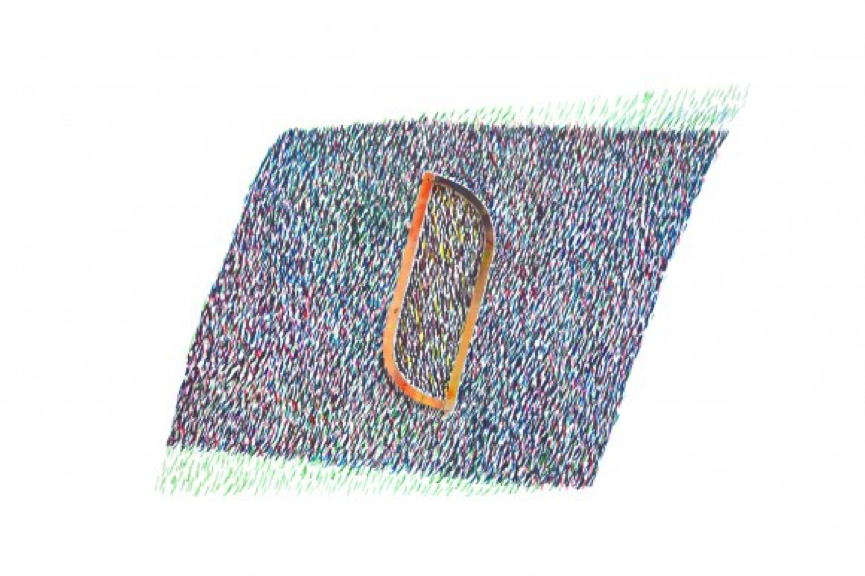
George Ridgeway | Members We Are (Aren’t We) | Watercolor and wood | 2016
New Scottish Artists presents fifteen artists who graduated in 2015 from Duncan of Jordanstone College of Art and Design, Edinburgh College of Art, Glasgow School of Art and Gray’s School of Art.
Works by Euphrosyne Andrews, Leo Arnold, Scott Baxter, Emily Binks, Miriam Chefrad Edward Humphrey, Rosanna Lee, Jamie Limond, David Evan Mackay, Hannah Murray, George Ridgway, William Spendlove & Bros. (Painters & Decorators), Josephine Sweeney, Guy Titterington, Felix Welch and Hamish Young go from painting to sculpture to video and performance.
The exhibition also displays the work of this year’s winner of the Fleming-Wyfold Bursary, George Ridgway (Glasgow School of Art) whose practice includes performance, music, painting and sculpture.
Symes Mews, NW1 7JE London | 21 March – 6 May | www.davidrobertsartfoundation.com
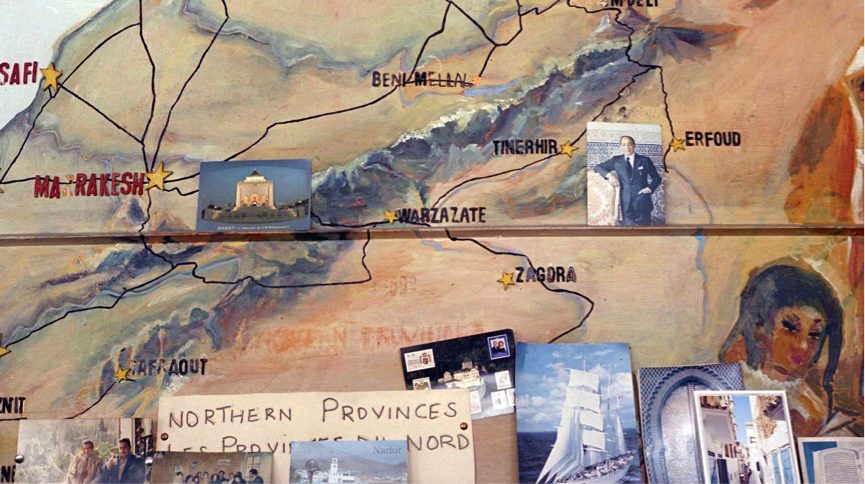
Yto Barrada | Tangier | 2009 | Image courtesy Sfeir-Semler Gallery
The Barjeel Art Foundation holds an extensive collection of art from the Arab world. This display looks at the rise of media-based practices among a generation of artists who emerged in the 1990s. Dealing with issues of migration, the aftermath of war and media representations of history and culture, artists such as Lebanon-born Walid Raad and Akram Zaatari construct real and imagined archives out of Beirut and Cairo, while Yto Barrada maps and photographs her hometown of Tangier tracking border crossings and those who hope for a better life across the Mediterranean.
77-82 Whitechapel High Street, E1 7QX London | 26 April – 14 August | www.whitechapelgallery.org
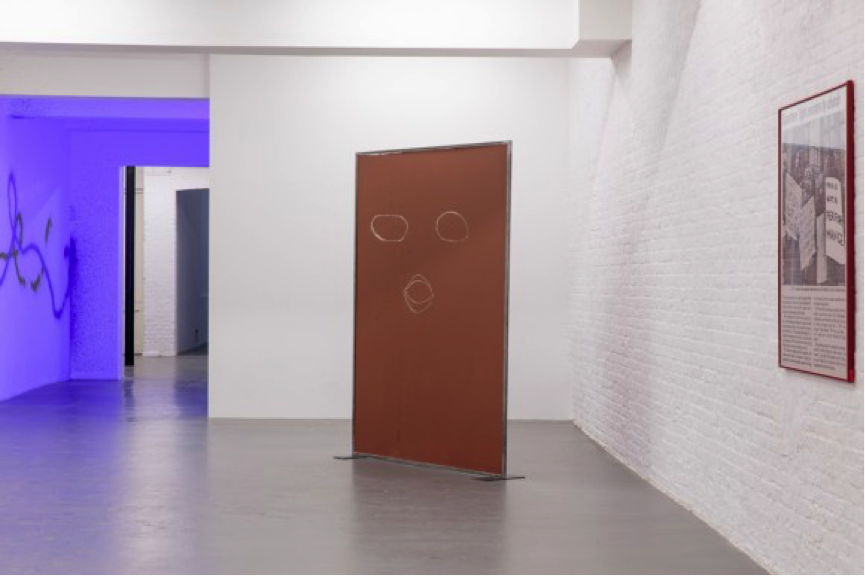
Installation view of Curators’ Series #9 | Ways of Living at DRAF | Photo: Tim Bowditch
This exhibition looks at artists who have sought practices inverse to the individualised, satellite modes in which we are increasingly expected to work, using materials and situations contingent to the places they live, no matter how internationally connected they may be. In doing so, these artists actualise, imagine or politicise the spaces in which they find themselves; fostering a still-needed sense of locality and producing directed responses to problems definitive of their time, place and situation.
Symes Mews, NW1 7JE London | 15 April – 23 July | www.davidrobertsartfoundation.com
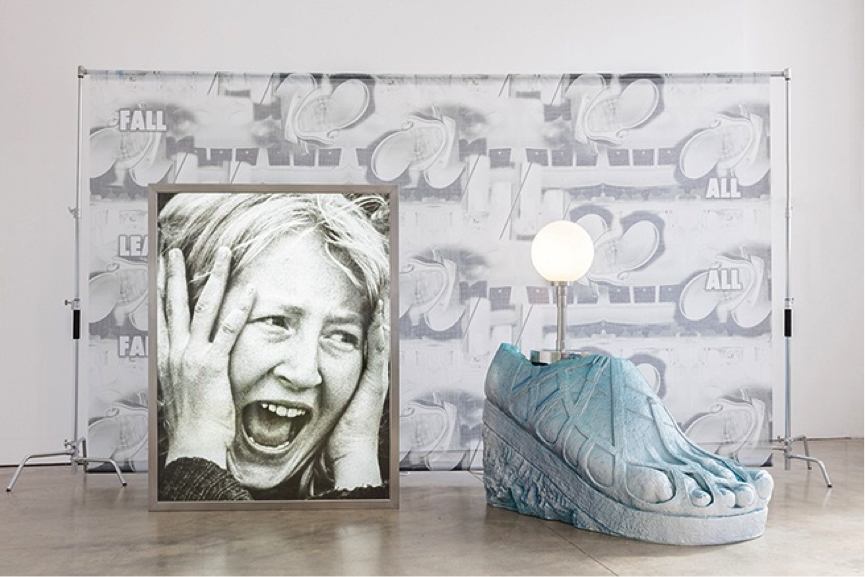
Guan Xiao | Flattened Metal in association with K11 Art Foundation | photo by Mark Blower
Xiao’s work is occupied with our incomprehension of the past, and the way in which the unknown gives rise to intriguing discussion in the present. She juxtaposes references from the past and present (or future), weaving visual and audio material (including video clips found on the internet), digital rendering techniques and objects, alongside so-called primitive and high tech elements, creating distinct and evocative installations. In this way, she offers fresh perspectives on what we perceive as the ‘new’ and the ‘old.
12 Carlton House Terrace, SW1Y 5AH London | 20 April – 19 June | www.ica.org.uk
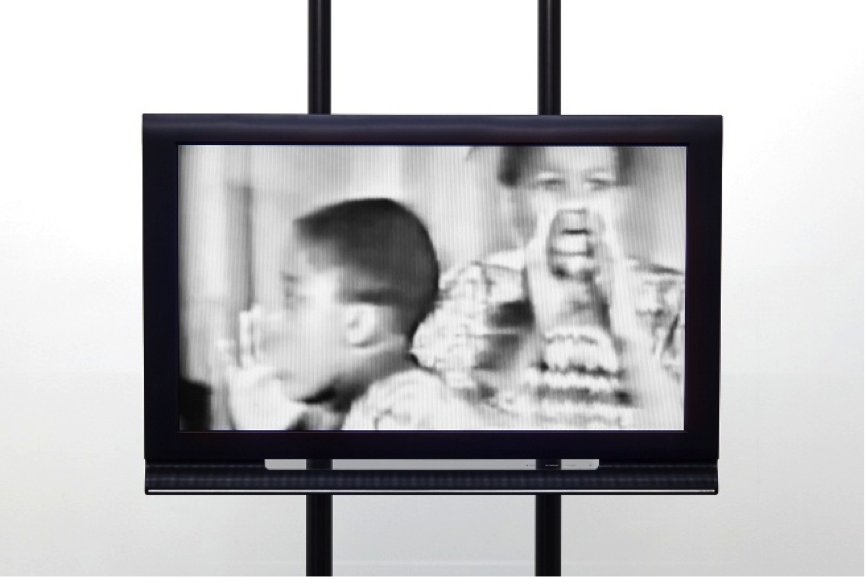
Martine Syms | Lessons I 2014
Fact & Trouble is an exhibition by American artist Martine Syms that examines the space between lived experience and its representation. Syms’ video series Lessons (ongoing), is a long, incomplete poem in 180 sections. Each piece is thirty seconds in duration and articulates a lesson from the tradition. One of these lessons is painted on the gallery walls. The videos use the idea of inheritance as a departure point, simulating the private-public unconscious of television shows, advertisements, animated GIFs, police cams, surveillance footage, Vines and other digitally-circulated formats.
12 Carlton House Terrace, SW1Y 5AH London | 20 April – 19 June | www.ica.org.uk

Installation view of Marcia Hafif: The Italian Paintings | 1961-1969 | Fergus McCaffrey, New York | 2016 | © Marcia Hafif; Courtesy of Fergus McCaffrey
Featuring almost fifty paintings and works created between 1961 and 1969, these virtually unknown paintings created by Marcia Hafif will finally be revealed to the people of the United States. This will be the first public exhibition of a body work essential to an account of American art of the 1960’s.
514 West 26th Street, NY 10001 | April 21 – June 25, 2016 | http://fergusmccaffrey.com/

Madeline Denaro | In a nutshell, life provides much opportunity | 2016
The Space Between Yes And No is a solo exhibition by Madeline Denaro, displaying paintings that seamlessly move between large blobs of chaotic colours and concentrations of patterns, giving a sense of stillness. Her most recent work truly shows her skillful manipulation of materials that have become somewhat of a quintessential when encountering her work.
35 N. Moore Street, NY 10013 | April 27 – June 4, 2016 | http://www.cherylhazan.com/

Pedro Wirz | Nascente Seca (Spring Drought) | 2016 | ©artnet
In his US debut at Kai Matsumiya, Pedro Wirz presents The Horse Who Drank Beer. Taking inspiration from folklore, mythical stories and legends from Pindamonhangaba, an area in the Paraiba Valley, Brazil, he created sculptures and wall works to invite the viewers to muse about the complex interplay between mythology and reality in modern society.
When? April 24 – June 5, 2016
Where? 153 1/2 Stanton Street New York,NY10002
Website: http://www.kaimatsumiya.com

Philip Guston, Last Piece, 1958, @artnet
Exploring a decade in which Philp Guston challenged aesthetic concerns of the New York school, making others question what it means to paint abstractly. This exhibition sheds light on a series of work that have not been fully appreciated by its peers.
When? April 26 – July 29, 2016
Where? 511 W. 18th Street, 10011, New York
Website: http://www.hauserwirth.com

Paul Resika, Red Pompeii, 2015–2016, @artnet
Focusing on variations of a specific still life theme; a pitcher and two shells, Paul Resika introduces his most recent paintings. All paintings feature the same objectives, but in various different styles, which as a result giving us a diverse impression of a pitcher and two shells.
When? April 28 – June 4, 2016
Where? 13810th Avenue, New York,NY 10011
Website: http://www.loribooksteinfineart.com/
If you think the recent arrival of hefty ropes, rings and roly-poly exercise balls at Bloomberg Space constitute a strange, new kind of gymnasium, you might be disappointed! These bland edifices are Eva Grubinger’s Five Problems, gargantuan versions of disentanglement puzzles, activities that originate in antiquity from Chinese, Asian and African cultures. The task of releasing metal or string loops from an object is designed to be both challenging and absorbing but can also develop a participant’s spatial awareness and logical thinking. As an installation, Grubinger’s enlarged puzzles are initially uninspiring but pose some really interesting ideas about how our perception of disentanglement puzzles change once they are enlarged on a grand scale. Grubinger has treated familiar objects in this way before, evident in her menacing black telephone headset from her series, Dark Matter (2003) or her over-sized, luxury-look fishing tackle in Decoy (2011).
Dissimilar from real life problems, disentanglement puzzles ensure a challenge that has a certain outcome; one that can be eventually solved. They present the opportunity to resolve an interesting challenge that may not be available in our working life but one that is relaxing and even pleasantly addictive. So once enlarged, can these puzzles become easier to resolve? Actually, they seem to have the reverse effect. Grubinger’s enormous puzzles require the head to crane and strain to resolve them thereby, eliminating not only their ability to relax the problem solver but also the participant’s pleasure in manipulating a traditionally tactile object. Therefore, her objects appear less as puzzles and more as sculptures, a situation that turns our attention to wider issues.

Eva Grubinger | Bloomberg Space | 2016
Disentanglement puzzles are traditionally made from metal, wood, beads and string but for her enlarged pieces, Grubinger has replaced these materials with rope, acrylic-coated balls, chains and chrome-plated metal. For example, on the floor of the gallery lies a wonderfully chunky pair of chrome links: an outsize luxury version of the familiar wire puzzle that spills from a Christmas cracker when pulled. Likewise, beads are swapped for a black shiny ball on a thick chain suspended dramatically from the ceiling. As a seemingly masculine symbol, the heavy ball is displayed at a distance, perhaps intentionally, from the apparent femininity of the chrome links. In this way, both objects exude power but their separation might also suggest gender inequality.

Eva Grubinger | Bloomberg Space | 2016
Equally, the flawless appearance of Grubinger’s monolithic pieces appear to reference the manufacture of disentanglement puzzles. Most of her sculptures resemble immaculately fashioned factory pieces, whereas her smooth wooden disc with a neatly threaded rope reference the finely-crafted high end of the market. Either produced cheaply as Christmas cracker contents or manufactured as intriguing gifts, perhaps disentanglement puzzles remain objects not because they are tactile but because they cannot be easily adapted digitally.
Bloomberg Space, 50 Finsbury Square, London EC2A 1HD | April 1 – May 28, 2016 | http://www.bloombergspace.com/
India’s richest woman with a $20 billion family fortune and a 27-story sky palace in India’s south Mumbai, billed as the world’s most expensive home for its $1 billion estimated cost – Nita Ambani is now eyeing the art world. Her new interest is the conservation of Indian art forms and making them more widely known internationally.
‘India’s Richest Woman Nita Ambani Eyes The Art World’
Blouin Artinfo | April 22, 2016 | Bibhu Pattnaik
The V&A’s new Exhibition Road entrance will be named after Britain’s richest man, Len Blavatnik, after his foundation donated money that brings the museum to 95% of fundraising for the £49.5m project.
‘V&A museum project boosted by billionaire’s donation’
The Guardiant | April 21, 2016
Roundups of movers and shakers are ubiquitous, but the one that makes the biggest waves every year is the TIME 100 list. The publication released their 2016 edition of the world’s most influential people on Thursday, and a number of art world names have been included.
‘Yayoi Kusama Is Only Artist Named in ‘TIME’s 100 Most Influential People’
Artnet | April 21, 2016 | Rain Embuscado
The Museum of Modern Art announces that Los Angeles-based philanthropist David Geffen has given a $100 million gift toward the Museum’s renovation and expansion, the largest gift to the institution’s Campaign.
‘David Geffen Makes $100 Million Gift’
Moma Press | April 21, 2016
He’s an über-modernist, favoring sleek lines and large expanses of glass. She bends more to the traditional, preferring soft curves and mullioned windows. So when designer Alison Palevsky and her husband, Alexander, began discussing plans for their home in Pacific Palisades, California, there was plenty of, shall we say, back and forth before a successful blending of their styles was realized.
‘HOUSE TOUR: Inside A Pacific Palisades Home That Is An Art Collector’s Dream’
Elle Decor | April 21, 2016 | Catherine Ettlinger
http://www.elledecor.com/design-decorate/house-interiors/a8444/pacific-palisades-home/
The new exhibition at the Serpentine Gallery in collaboration with Moderna Museet (Stockholm) presents the work of Swedish painter Hilma af Klint (1862–1944), who is now regarded as a pioneer of abstract art.
Not many people are familiar with af Klint’s work because her paintings were not seen publicly until 1986, although she was working in the early 20th century, pre-dating the first abstract masters such as Wassily Kandinsky, Piet Mondrian and Kazimir Malevich. Painting in near isolation from the European avant-garde, af Klint stipulated in her will that her work should be kept out of the public eye for 20 years after her death, fearing that it will be misunderstood by her contemporaries. The paintings were hidden from the public until a 1986 Los Angeles exhibition and brought to a wider audience only in 2013 at Stockholm’s sensational exhibition, Pioneer of Abstraction. Painting the Unseen at the Serpentine Gallery in London is set to give the artist deserved recognition and celebration of her work.
The show curated by Melissa Blanchflower is depicting various series spanning over 60 years of the artist’s life. Flawless wall text clearly annotates the paintings without distracting from it allowing wonderful colours translate immediately from small to large in all the paintings.

Group IX/SUW, No. 17. The Swan, No. 17′ | 1914 | ©Moderna Museet, Stockholm
The artist’s central body of work is the monumental series titled The Paintings for the Temple. Claimed as the first European abstractions it’s predating by several years any such works by Kandinsky, Malevich or Mondrian, as the official birth of abstract art is dated to 1910.
Consisting of 193 paintings in various series and subgroups, they all symbolise a path towards harmony between the spiritual and material worlds. Even more interesting that the work itself is the actual story behind the artist’s works. Fascinated by the occult in the late 1890-s, af Klint founded a group of female artists, The Five, in order to talk to spirits that could supposedly communicate through the act of drawing. “The pictures were painted directly through me, without any preliminary drawings and with great force. I had no idea what the paintings were supposed to depict,” Klint explained in one of her diaries.

Primordial Chaos | ©Moderna Museet, Stockholm
Lines and spirals depicted in the paintings seem to indicate movement, along with words, letters and different forms, such as a spiral shell, a snail and waves. Af Klint’s notebooks contain a vague explanation of colours, images and text that are used in her works. The blue colour or the lily for instance, represents femininity, whereas the use of yellow stands for masculinity.
The show is dynamic in colour and form and mystical in its abstraction, presenting the artist who dared to think beyond her time, stepping out of what was commonly accepted. Whether it was through her spiritual séances or not, she clearly had visions about bigger contexts trying to understand the world.
Serpentine Gallery, Kensington Gardens, London W2 3XA | March 3 – May 22, 2016 |
www.serpentinegalleries.org
In 2009, two years before news of the Knoedler Gallery’s $70m sale of fake Abstract Expressionist paintings began to emerge, Ann Freedman resigned as director. Two years later, the venerable gallery closed down and the lawsuits against Knoedler and Freedman began to flood in.
‘Former director of scandal-beset Knoedler Gallery breaks her silence’
The Art Newspaper | April 18, 2016 | Laura Gilbert, Bill Glass
James Franco has famously resisted being identified as merely an actor, pursuing a simultaneous life in the art world — making videos of dollhouses split in half, painting fat pets, and restaging Cindy Sherman’s iconic 1977–1980 “Untitled Film Stills,” with Franco himself standing in for Sherman, who was (in her own version) standing in for a variety of actresses in B-movies.
‘In conversation with James Franco’
Vulture | April 18, 2016 | Jerry Saltz
A personal art collection, regardless of how expensive the pieces may be, is what makes a house a home. These accents are essential finishing touches—they can elevate even a room filled with big-box pieces to something one of a kind. There are some people who simply have a great eye for art.
’16 Envy-Inducing Celebrity Art Collectors’
My Domaine | April 17, 2016 | Julia Millay Walsh
Barry Flanagan’s pile of sand, one ton corner piece, would have raised a few eyebrows in 1967 but it set the precedent for changing the nature of sculpture at the time. Like many of his contemporaries, Flanagan criticised the British art school’s conventional approach to teaching sculpture which he regarded as limiting to artistic development. While Gilbert and George were entertaining the masses with their ‘Living Sculptures’, Flanagan explored alternative materials for his pieces choosing sand, plaster, hessian and metal. Experimental and independent, he was fascinated by the properties of materials, their capacity to contain other materials and respond to light. His early textural works, made from pre-sewn bags which he packed with sand, allowed the sculptures to take their own form. In order to convey the process of sculpture, he produced a film of a girl lying under a continuous stream of sand which gradually covered the contours of her body.
Flanagan’s artistic life was without pretence; he appreciated a range of technical skills such as building, frame-making and baking learnt prior to his art training at St. Martin’s School of Art. Animal, Vegetable, Mineral has taken its title from Flanagan’s first solo exhibition of conceptual art at the Rowan Gallery, London in 1966. Curated by Dr Jo Melvin, this exhibition focuses on the sculptor’s early work from the 1960s, 1970s and 1980s comprising concrete poetry, sketches, log books film and photographs.

Barry Flanagan, Her Warm Tit Rolls, 1981
Flanagan often took inspiration from everyday items including his wife’s airing cupboard; his controversial piece, pile 3 ’68 was essentially a pile of blankets. The different textures of his marble and stone sculptures, developed from his earlier textile experiments, sometimes display an element of ambiguity. Her Warm Tit Rolls, originally modelled in clay, recalls the spongy quality of a snail but with the dimpled appearance of older female skin. His fascination for hares stemmed from his interest in their mythology and peceived enigmatic nature. His bronze hare sculptures expressed human elements and an almost cartoon-like quality, a combination which he felt conveyed geater expression particularly in relation to the animals’ ears.

Barry Flanagan, Ball and Claw, 1981. Waddington Custot Galleries
The most interesting part of this exhibition are Flanagan’s preliminary sketches of hares and working drawings for his sculptural pieces. He used his curly snail symbol to experiment with a variety of materials either to create majestic coils of copper or graceful spirals of rough hessian or even to achieve the appearance of cardboard such as his ‘torn’ steel sheet sculptures. Animal, Vegetable, Mineral imparts a fascinating insight into Flanagan’s enthusiam for materials, his thought process for his projects and preparation for later work.
Waddington Custot Galleries, 11 Cork Street, London W1S 3LT | March 4 – May 14, 2016 |
http://www.waddingtoncustot.com/
With the spring art season comes a slew of gallery exhibitions, museum shows, and art fairs brimming with the latest crop of young artists. In preparation, we consulted hundreds of galleries and sifted through thousands of artworks to uncover the 30 most promising up-and-coming artists across the globe.
’30 Emerging Artists to Watch This Spring’
Artsy | April 13, 2016 | Artsy Editors
The new show at London’s Barbican explores Britain as seen through the eyes of international photographers. Curated by iconic British photographer Martin Parr, the exhibition includes everything from social documentary and portraiture, to street and architectural photography by leading photographers of the 20th and 21st century. The big names include Henri Cartier-Bresson, Robert Frank and David Glodblatt, as well as a range of artists who are less well-known outside the photography world.
In the mid-20th century, photography was used as a force for social change. The works on display demonstrate a vivid canvas of Britain’s social, cultural and political identity offering an interesting reflection of how the country is perceived by those outside its borders over the last 80 years. Martin Parr explains: “the exhibition will reveal a very different take on British life than that produced by British photographers. It is both familiar and strange at the same time.”
Captured in each photographer’s own distinctive style, the works explore different characteristic of life and perspectives on British life, from the busy capital to the rustic north.
The show starts in the mid-1930s with Edith Tudor-Hart’s images of London’s East End to the slum housing areas of Tyneside. Photographs capture the child welfare, unemployment and homelessness in a very realistic way, introducing a naturalistic style that shows people in their own environments.

Edith Tudor-Hart – Gee Street, Finsbury, London, ca. 1936 © Edith Tudor-Hart / National Galleries of Scotland
Henri Cartier-Bresson’s photographs of the Coronation of King George VI in 1937 show Britain enjoying the relief between the World Wars. The photographs are sheer joy: the crowds lining the streets in cheery celebrations and posing proudly in front of Trafalgar Square, a man fast asleep in a pile of newspapers in the middle of the crowd, ‘Gawd Bless Yer’ daubed on an East End wall.

Henri Cartier-Bresson – Coronation of King George VI, Trafalgar Square, London, 12 May 1937 © Henri Cartier-Bresson / Magnum Photos
Some of the images are shot in the nation’s less-documented places, such as Robert Frank’s portrayal of life alongside the coal mining towns of South Wales in the early 1950s, the conflict in Northern Ireland recorded by Giles Peress and Akihiko Okamura; and desolate 1980s Glasgow as seen by Raymond Depardon.
The show also includes works made right up to the present day. American photographer Bruce Gilden takes grotesque close ups of people unexpectedly as they walk down the streets of Midlands and Essex. The portraits are far from flattering, in fact they are quite intimidating, revealing every line, blemish and pore. Showing harsh reality of people’s every day lives, these large-scale images are repulsive, making the viewer feel uncomfortable.

Exhibition view. Bruce Gilden, 2011 @Tristan Fewings/Getty Images
Strange and Familiar gives a real insight into Britain, as seen from the outside, reaffirming a number of cultural clichés about the nation and portraying the fascinating evolution of both Britain and photography.
Barbican Centre, Silk Street, London EC2Y 8DS | Until June 19 |
http://www.barbican.org.uk/
The obscured features of Jessica Rayner’s mystical landscapes are like a blue gas flame enveloped by a warm glow. By reworking the images of simple beach scenes using polarising filters, she plays with our capacity to process light and imagery. Rayner produces images that are not visible to the eye using a selection of man-made and natural lenses, methods that are unrevealed to the viewer and which therefore retain an element of ambiguity throughout her work. Her unusual compositions demonstrate how the power of the lens can magnify, enhance or intensify our experiences of the world around us. Rayner uses natural lenses as a subject matter in her Solsten lightboxes, a recursion of weathered sunstones backlit to enhance their contrasting symphonies of brilliant blues and emerald greens. Other work references the use of Fresnel lenses used in lighthouses whose spherical prisms produce a strong beam. Luminous Flux takes its name from the quantity of light energy in visible wavelengths and presents an imaginative array of photographs, installations and delicate designs on glass or textile whilst also concurrently drawing attention to the history of the lens.

Jessica Rayner, Optical Aberrations I, 2016
Rainbows were depicted by early artists as an earthy signifier to the celestial body of Christ. On a more recent note, the Icelandic artist, Olafur Eliasson produced a shimmering rainbow with a perforated hose to explore spatiality. However, Rayner is fascinated by our perception of the rainbow as just a visible arc of colours but has counteracted this notion by producing a circular rainbow with the use of a telescopic mirror for her work, As Seen Below the Horizon. This work and her Optical Aberrations series underlines the 18th Century problem associated with the early design of the telescope in which glass lenses created chromatic halos around the objects they magnified. Although distorted by their centre of curvature, Sir Isaac Newton’s mirrored lenses corrected this issue at a later date.

Jessica Rayner, Untitled II (sun capture, 9th Aug, 12 o’clock, 20 minutes, gentle wind) 2016. Christine Park Gallery
Central to the exhibition is a wall projected video of a glass marble rolling inside the rim of a petri dish which is refracted at timed intervals by a revolving glass prism, causing the moving image to diverge into shadows and embryonic forms. Geometric patterns appear in Rayner’s sun capture series developed by the digital manipulation of sun prints. The petal like quality of Untitled II produces a similar image to her work, Rate of Decay produced by another technique involving time-lapse photography. The last exhibit echoes the watery blue tints of her photographic work, a slither of printed silk draped like a reel of film revealing a repeating pattern of diffused orbs and blurred outlines.
Christine Park Gallery, 35 Riding Street, London W1W 7EA | March 11 – April 30, 2016 |
www.christinepark.net
After navigating my way around the bright labyrinth of corridors that make up the Barbican Centre, on entering the dark, unusual space that houses Imran Qureshi’s latest exhibition my senses became instantly disorientated. The only light came from the beams that shone on each piece, making for an unsettling opening impression. But this initial sense of confusion is a deliberate device used to enhance the disorder that feeds into Qureshi’s work.
The 35 new miniature paintings commissioned by the Barbican, are rich with gold and red epitomising the opulence and vibrancy of his home of Lahore in Pakistan. The pieces are exquisite each the product of a labour of love and intense attention to detail. Qureshi’s practise was perfected by the Mughal masters of South Asia over five centuries ago and is the demanding tradition that forms of the basis of his work. The composition of each scene, featuring flowers, leaves, birds and trees, stays faithful to the convention as Qureshi attempts to incorporate a sense of his heritage into contemporary art.
Where the Shadows are so Deep is displayed in the Curve Gallery; with the curved space creating the desired feeling that Qureshi’s work spans cultures and is part of a distillation of hours of passionate toil. A major part of Qureshi’s practise involves playing with scale and surprising the viewer, which he achieves through bringing a sense of chaos to proceedings by splattering paint across the room in a seemingly violent outburst.
The miniature paintings are hung against a backdrop of crimson red paint splashed across the white walls, and even the miniatures, which drips across the floor like the aftermath of a brutal crime scene. The blood like pools added to my feeling of unease, as even the gallery attendant was diligent in her reminder that you ‘mind the work on the floor’, creeping around as if I was an illegal observer at risk of contaminating the scene. But as you look closer at the angry red splatters there are white flowers sitting delicately amongst the chaos, a subtle reminder of the fragility of the meticulous tradition in a nod to the Mughal masters.
Qureshi’s work effortlessly combines tradition and a subversion of painting conventions, as paint spills out from beyond the canvas. The echoing Curve gallery creates a sense of vastness that gives the miniatures an intense impact, as Qureshi undermines the viewer’s anticipation of something purely decorative with something more disturbing. His work is powerfully provocative as he attempts to create pieces where life and death work together, as the initial violence becomes something poetic on closer inspection.

LONDON, ENGLAND – FEBRUARY 17: Imran Qureshi: Where the Shadows are so Deep installation images at The Curve at Barbican Centre on February 17, 2016 in London, England. (Photo by Tristan Fewings/Getty Images for The Barbican Art Gallery)
The Barbican Centre, Silk Street, London EC2Y 8DS | 18 February – 10 July
http://www.barbican.org.uk/
For the first time the works of two giants of mid-to-late-20th century visual art, Richard Avedon and Andy Warhol are juxtaposed at Gagosian gallery in Britannia Street, one of the most elegant art spaces in London. Avedon and Warhol, both post-war American artists, who ultimately changed art with their parallel creative outputs that sometimes overlapped.
The show is connecting dots between the fashion photographer and pop art master in a very inspiring and reflective way, showcasing more than 50 artworks that span from 1950s to 1990s. The works focus on common subjects in the two artists’ lives, including social and political power, mortality, and the glamour, celebrities and show business. Together, Avedon and Warhol provided a unique account of post-war American pop culture, the era when legends were born and icons were made.

Andy Warhol, Liza Minelli, 1976 © 2015 The Andy Warhol Foundation for the Visual Arts, Inc.
The paths of two artists crossed repeatedly, but they weren’t friends as such. In fact, Warhol described Avedon as “horrible” in his diaries. Nevertheless, both artists realised the creative potential of repetition and mass production. Their most notable images, produced in response to changing cultural values, are now considered icons of the twentieth century.
The show is about duality. Two different lives, two mediums and two sets of outcomes displayed side by side to reach one objective. It is interesting to see and compare how both artists portrayed one iconic figure, such as Marilyn Monroe for instance, in two completely different ways. Information labels don’t exist here because the faces are so famous they don’t need presentation.

Richard Avedon, Marilyn Monroe, 1957 © The Richard Avedon Foundation
As well as celebrities and show business, another shared concern was the tyranny of political power that both artists expressed in their works. The highlights of the exhibition include Avedon’s The Family (1976). Sixty-nine portraits of members of the elite political power in America in the 1970-s, commissioned by Rolling Stone. This can be compared to Warhol’s enormous silkscreen portrait of chairman Mao Zedong, showing a great deal of interest in the Chinese political situation in 1971.
Artists’ professional lives crossed briefly when Avedon photographed Andy Warhol and members of The Factory, Warhol’s crew of aspiring actors and directors in 1969. The Factory, was a well-known gathering place for distinguished intellectuals, drag queens, celebrities, and wealthy patrons. A giant multiple photoshoot was the result of Avedon’s experiments with eight-by-ten inch view camera on a tripod in order to yield images with extreme detail.

Detail of Richard Avedon’s The Factory, 1969 © The Richard Avedon Foundation
Warhol’s painted and printed artworks are unusual, unexpected and original when first seen. In contrast, Richard Avedon’s black and white photographs are carefully composed portraits of people posed in his studio, against white background. The success of the show is easily explained by its ability to appeal to viewers who admire glamorous black and white photography as well as those preferring funky pop art.
Gagosian Gallery, 6-24 Britannia Street, London | Until April 23, 2016 |
www.gagosian.com
LONDON
Blair Thurman: Mature Blonde | Almine Rech Gallery
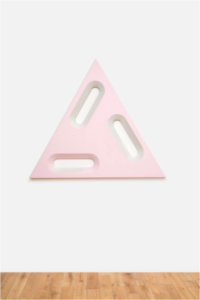
Blair Thurman | Zardoz | 2016 | Acrylic and canvas on wood
Hailing from New York, Blair Thurman, the artist best known for his large neon-installations and paintings on shaped canvases and wood, showcases his first solo exhibition at Almine Rech gallery. Hailed by many in recent years as one of the hottest contemporary artists on the scene, Thurman’s new work comprises of more vibrant ‘pop minimalist’ geometric shaped canvases, drawing from mechanical and metallic elements of car culture.
11 Savile Row, 1st floor, Mayfair, London W1S 3PG | 31 March – 14 May | http://www.alminerech.com
John Kørner: Apple Bombs | Victoria Miro
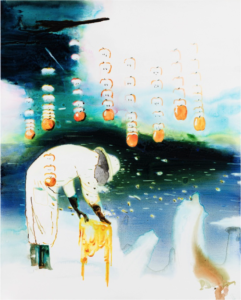
John Kørner | Organising Honey | 2016 | Acrylic on canvas
On show in Mayfair’s Victoria Miro gallery, the Danish artist presents Apple Bombs. A new body of work, Kørner’s wet-into-wet paintings create blurry, mismatched scenes of everyday life suspended on two dimensional planes. Previously taking on issues involving sex workers and Danish soldiers fighting in Afghanistan, the hazy, surreal settings only add to the messages of uncertainty, whilst dipping into dialogues concerning human relationships, survival and consumption.
14 St. George St, London W1S 1FE | 8 April – 14 May | http://www.victoria-miro.com
Keri Uematsu: Invisible Force | Simon Lee
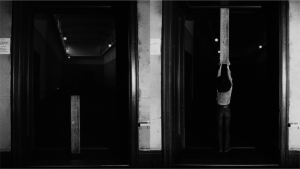
Keri Uematsu, Vertical Position, gelatin silver print, 1973
Despite a longstanding international career, this is Japanese conceptual artist Keiji Uematsu’s first show in the UK. This exhibition features a collection of sculptures and photographs over the past 45 years, tracing Keiji Uematsu’s fun experiments with gravity and the sculptural possibilities of the human body.
12 Berkeley St, London W1J 8DT | 8 April – 6 May | http://www.simonleegallery.com
David Shrigley: Drawings and Paintings | Stephen Friedman
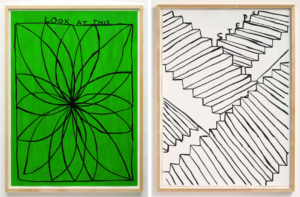
David Shrigley, Untitled, 2016, oil stick on canvas
Working with oil stick for the first time, Shrigley’s unmistakable line is put alongside thick, brightly-coloured paint, bringing the characteristically cartoonish style into another dimension. As if to comment on the simplicity, the dry humour of Shrigley’s satisfyingly mundane situations are captioned with lines like ‘Look At This’, remarkably appropriate considering it is this simplicity of style that is so uniform to Shirley.
44 – 46 Riding House Street, London W1W 7EX | 11 March – 8 April | http://www.joshlilleygallery.com
Spencer Finch: The Opposite of Blindness | Lisson Gallery
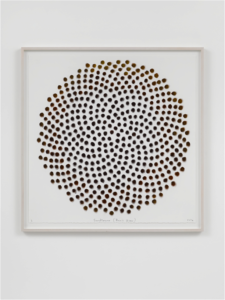
Spencer Firth, Sunflower (Bee’s View, Full Sun Improved), pastel and pencil on paper, 2016
The title of the exhibition, a line taken from Anne Carson’s Autobiography of Red, refers to the notion of a broach approach to seeing; trying to get beyond what we normally think of as vision. Through a new installation, watercolours and pastels on paper, Finch tests the limits of objectivity, pursuing poetic ends with scientific clarity, and analyses the points at which conventional vision vanishes to become something else.
27 and 52 Bell St, London NW1 5BY | 1 April – 7 May | http://www.lissongallery.com
NEW YORK
Alexis Rockman: Bioluminescence | Carolina Nitsch Project Room
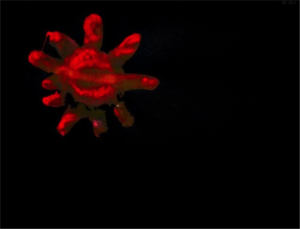
Alexis Rockman ,Untitled (Coronet Medusa), Gouache on paper, 2013.
Rockman, who has said his work was inspired by childhood visits to the American Museum of Natural History, emerged in the 1980s with fantastical paintings of flora and fauna, often portrayed in post-apocalyptic setting, limned in a style that married dire ecological warnings with magic realism. His career has included work for Hollywood, most notably the concept drawings he created for Ang Lee’s film of Life of Pi. His latest show plunges into the briny deep with images of bioluminescent sea creatures lighting up gouaches on black paper.
534 W 22nd St, New York 10012 | 1 April – 30 April | http://carolinanitsch.com
Bernard Frize: Dawn Comes Up So Young | Galerie Perrotin
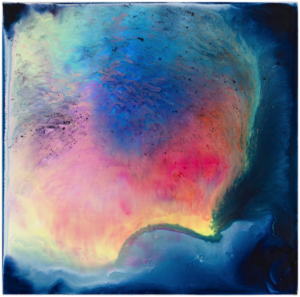
Bernard Frize, Doine, acrylic and resin on canvas, 2015.
Bernard Frize occupies a unique position in the discourse of abstract painting. By using the colour in an experimental, or technical-mechanical manner, Frize draws attention to painting as a handicraft, while also discounting the idea of artistic creation. The resulting pieces, alluring and locked at the same time, have become a trademark of his oil-slick painting style.
909 Madison Avenue & 73rd Street, Upper East Side, New York 10021 | 03 May – 18 June | https://www.perrotin.com
Serge Poliakoff | Cheim & Reid
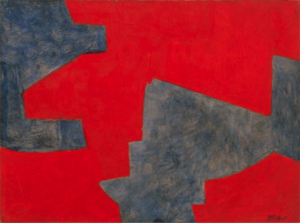
Serge Poliakoff, Composition Abstraite, 1962
Cheim & Read exhibits a survey of paintings by one of the foremost post-war European abstractionists, the Russian-born Serge Poliakoff (1900–1969). A product of the Russian diaspora that followed the Bolshevik Revolution, Poliakoff fled to the West, educating himself in the art schools and museums of London and Paris. He painted every day while raising a family, supporting this life by playing Russian folk songs on guitar in Parisian nightclubs.
547 W 25th St, New York 10001 | 31 March – 30 April | http://www.cheimread.com
Gerasimos Floratos | White Columns
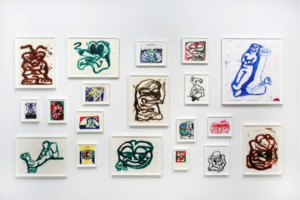
Installation view Gerasimos Floratos, White Columns 2016.
As objects, Floratos’s paintings appear slapdash with their crooked stretcher frames and puckered canvases. But this funky presentation nicely compliments the artist’s quasi-abstracted, cartoonish style and penchant for squashed compositions depicting an odd range of subjects, from New York street characters and scenes to Greek mythology.
320 W 13th St, entrance on Horatio St, New York 10014 | 1 March – 16 April | https://whitecolumns.org
Ibrahim El-Salahi: Alhambra | Salon 94

Installation view Gerasimos Floratos, White Columns 2016.
Alhambra, the inaugural exhibition of Ibrahim El-Salahi at Salon 94, will feature new works by the Modernist master painter and pioneer of Sudanese art. Recognised as the father of African and Arab Modernism, El-Salahi’s paintings and works on paper harmonise African, Arab, and Islamic visual sources with twentieth century European art traditions. Born in Omdurman, Sudan in 1930, his remarkable career has had a profound influence on succeeding generations of artists from the region and across the globe.
243 Bowery, New York 10002 | 1 March – 23 April | https://www.salon94.com
Das Institut is a collaborative project between Adele Röder and Kerstin Brätsch, artists from different aesthetic practices who share the same vision or ritual in which humour and play predominate over daily life. Utilising the force of cosmic abstraction, they present a mystical brew of experimental pieces produced by combining their own work with that of other artists, craftspeople, sound and filmmakers thereby rejecting individual artistic creativity. The result is a cacophony of experimental ideas exploring the effects of light and transience on the human body incorporating a whole gamut of materials (neon light, stained glass and even cake ingredients to name a few). These artists are not interested in presenting their vision clearly but delight instead in uncertainty, presenting their installations within seemingly unconnected zones thereby promoting a sense of discord and puzzlement. Their opening gesture, a pair of cheeky neon breasts swaps tiresome intellectual chuckles for a refreshing change of the obvious.
The bodies of Röder and Brätsch feature in their work throughout, appearing initially in Am Sonntag (2016) from their series ‘When you see me again it won’t be me’, a crazy slide projection of nibbled away faces, knowing looks and nutty postures.
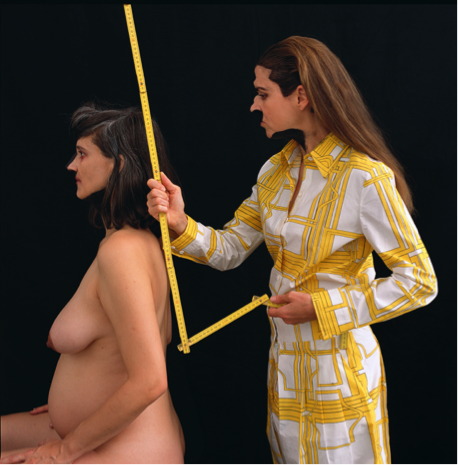
Am Sonntag (2016) Das Institut, Photograph: Kathrin Sonntag
Blobs of ‘cytoplasm’ skim the surface of the Absolution Well (2016), an optical illusion of depth and infinity devised by concentric hoops of blue neon interspersed with stained glass shelves. This particular piece introduces the many possibilities afforded by combining Röder’s minimalist light installations with the neo-expressionist stained glass work of Brätsch. Further on, neon tubes draggle around a succession of portraits bearing medieval-inspired characters with algetic expressions and deformities formed from uncut gems and a sugary confection of enamel and lead. The haphazard positioning of neon in the latter is slightly less successful and more of a superfluous than complementary element but acts as an effective warm up to the theatrics of their next installation, North Tomb (2016).
Inspired by the tension and sporadic release of droplets, Brätsch’s majestic array of marbled panels denoting the entrance to the tomb presents a swirling mass of moss drenched inks suggestive of human forms. Within, the artists’ collaboration is exposed at full throttle against the sound track of Sergei Tcherepnin’s migraine mix of morphed jungle beats. Röder’s slick of neon glows gently in the dark beneath Brätsch’s lurid suspension of animalistic images, spidery members and psychedelic tongues fulfilling an apparent desire for chaos.
Outside the tomb, the sight of Röder’s restful solar prints depicting recumbent body postures provide contrast from the throng. The outcome of lying on light-sensitive linen combined with a fascination in the similarities between her own body and the position of exhumed human relics has resulted in an attractive set of images.
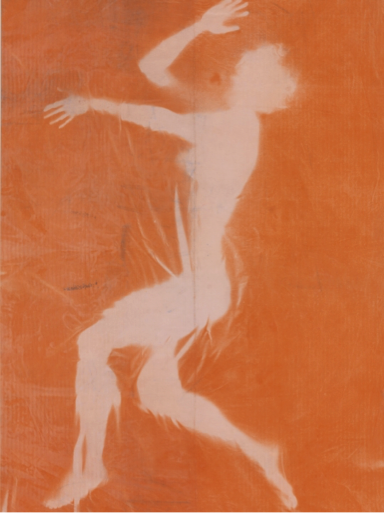
Solar prints, Adele Röder, Untitled, 2013. Photograph: Gunnar Meier
Serpentine Sackler Gallery, West Carriage Drive, Kensington Gardens, London W2 2AR | March 3 – May 15, 2016 | http://www.serpentinegalleries.org/
Purchased in 1996 for $950,000 by French music producer, newspaper publisher, entrepreneur and passionate lifelong art collector Jean Lignel, this West Village carriage house received a renovation by architect Jeffrey Flanigan that transformed the 1834 landmark into both a family home and a made-to-order art gallery with 6,700 interior square feet and 1,825 square feet of outdoor space.
‘An Art Collector’s $14.5M West Village Carriage House Is Both Private Gallery and Family Home’
6Sqft | April 1, 2016 | MICHELLE COHEN
From fervent students pouring over bowls of fruit to artists incorporating natural materials into their practise, nature has long been a central theme within art and design. As the human footprint continues to encroach upon our environment, art is used by some to explore how humanity interrelates with natural order. A topic full of breadth with the potential to create room spanning installations or intricate studies, yet artists still fall into the trap of presenting work that moves dangerously close to becoming completely two dimensional.
For conceptual artist Julian Charrière the ‘humans versus nature’ debate informs his work, which during the first decade of his career took him to some of the remotest corners of the earth. The Swiss-French artist explores the inherent tension between what occurs naturally and what is due to human activity as part of giving a platform to ecological and environmental issues. Charrière’s work is diverse featuring film, installation and sculpture as he scrutinizes our constant demand for technological advances that have vast implications for the future of our ecological system.
The Parasol Unit Foundation, a non-profit institution that is committed to artists and their creative endeavours, is internationally recognised for its thought-provoking exhibition programme. The work of Charrière echoes the Foundation’s philosophy for pushing the bounds of the medium, becoming the most recent addition to the list of exhibitors with his first UK solo exhibition For They That Sow the Wind. The series of work takes the viewer on a journey through the isolated regions Charrière travelled to as part of creating each piece. From the glaring white prehistoric lake, Salar de Uyuni, in Bolivia to the haunting landscape of Stalin’s nuclear test sites in Kazakhstan, Charrière’s work is driven by an adventurous curiosity that becomes inescapably infectious.
The film ‘Somewhere’ and accompanying photographic series ‘Polygon’ document the devastation at the result of human hands in Semipalatinsk, the site where between 1949 and 1989 the Soviet Union conducted 456 nuclear tests. A landscape that when described still evokes a sense of horror that has become rooted within the remaining wasteland. But not only does Charrière bring a flicker of past into the present, he also humanises even the most alien of landscapes. The hazy quality of the photographs in ‘Polygon’ was achieved by Charrière exposing them to radiation before development, each bearing a physical trace of radioactivity. The resulting images are scarred with cloud-like shapes bursting across the sky, taking an event that happened years ago and making it seem mysteriously futuristic.
‘We Are All Astronauts’ injected some vibrancy and playfulness into the exhibition an installation featuring various globes, dating from 1890 to 2011. The globes speckled with muted tones and flashes of turquoise appeared to be floating, a fantastical piece that has a strong political message at its core. Charrière sought to represent equality through eliminating geographical divisions between countries and continents by sanding the surface of each globe, letting the dust intermingle underneath.
Julian Charrière is an artist that presents beautiful objects amongst stark scenes, with the most fascinating quality about his work this ability to seek out an element of splendour in even the most barren of places.

‘Future Fossil Spaces’ (2014). Image courtesy of Jessica Rayner
Parasol unit foundation for contemporary art, 14 Wharf Road, London N1 7RW | http://parasol-unit.org/home http://julian-charriere.net/
Nikola Tamindzic, a New York-based photographer is someone who delivers raw and seemingly unplanned photographs. He manages to capture the essence of the person he shoots, the vibe of the city he depicts, the hectic feeling of the environment, and the strong statements that lie behind his works.
‘FUCKING NEW YORK WITH NIKOLA TAMINDZIC’
Widewalls | March 29, 2016 | Ana Moriarty
In 1882 the 12th Duke of Hamilton was forced to sell his grandfather’s immense collection of paintings, prints and decorative arts. The Berlin Kupferstichkabinett (Prints and Drawings Museum) bought many of the prints and manuscripts from Sotheby’s before they even went to auction, despite objections from John Ruskin and the Royal Family. At the heart of this collection was a set of illustrations of Dante Alighieri’s famous epic poem, The Divine Comedy, by Renaissance artist Sandro Botticelli.
The Courtauld Gallery offers an exceptional opportunity to explore the great master’s interpretation of one of the canonical texts of world literature. The exhibition presents a selection of thirty exquisite drawings from around 1480 – 95, in which Botticelli depicted scenes from Dante’s journey through Hell, Purgatory and Paradise as envisaged in the poem. Ten works capture each of its three parts; in hell Dante encounters moneylenders, corrupt clergy, evil sorcerers and other sinners, in purgatory he watches as the negligent and gluttonous perform penance, and in paradise he finds his lost love from youth, Beatrice. The masterful drawings are accompanied by a rare selection of manuscripts from the time of Botticelli, including the monumental ‘Hamilton Bible’ and Courtauld Gallery’s own collection, which includes the master’s large altarpiece of The Holy Trinity with Saints John and Mary Magdalene, dating to the same years as the Dante series.
Spanning a vast emotional, technical and narrative range, Botticelli’s illustrations represent an absolute embodiment of Renaissance achievement and conception of the artist as an individual creative genius. It took Botticelli almost 20 years to bring the drawings to a state of near-completion.
Biographer Giorgio Vasari described Botticelli as a man, who was “obsessed with the project, bringing infinite disorder into his life by neglecting work”.
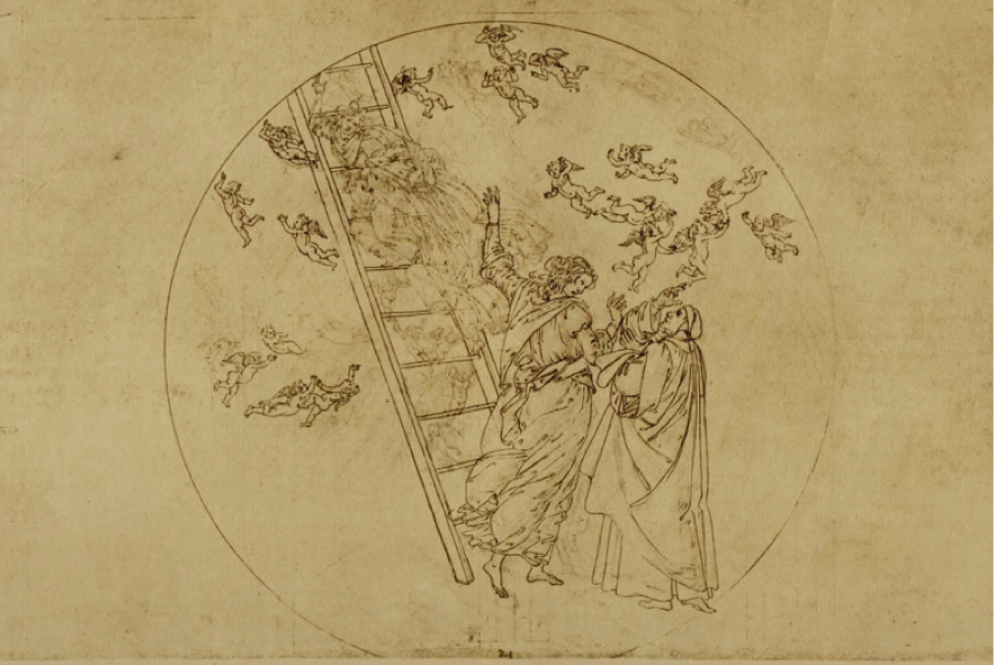
Dante’s Paradiso. c1481-1495 © Staatliche Museen zu Berlin, Kupferstichkabinett
Botticelli’s lines are as fine as spider’s silk, sometimes barely seen at all. The first impression is that they are very faint and sketchy, but once you look closer, you discover marvellous and delicate figures, most in nude, scattered at different angles, in animated poses. Often characters are depicted several times in the same drawing, as a way of illustrating their movement through a scene. In one image, Dante’s figure has two heads, to show that he is turning to see over his shoulder.
While working on the illustrations, Botticelli was exploring the perspective and the position of the figures in a three-dimensional space. A macabre highlight is the artist’s gruesome full-length illustration of Lucifer, shown gorging on the souls of three arch traitors. For this depiction of Satan, Botticelli used two pieces of vellum stitched together – a double-fold centre-spread of evil.

Centre of Hell. c1481-1495 © Staatliche Museen zu Berlin, Kupferstichkabinett
Some of the drawings have traces of colour, suggesting that they were initially all going to be completed with colour, but instead they remained a fragile pen lines on a blank cream background. The final page is unfinished and there is a theory that it was because Botticelli couldn’t visualise Dante’s conceptual text. It is difficult to understand what effect Florence’s rough times had on Botticelli’s work. One thing certain is that these fragile drawings show a spiritual and artistic journey, not only of the great Dante, but also of Botticelli.
Courtauld Institute Of Art, Somerset House, The Strand, London WC2R 0RN | February 18 – May 15, 2016 | courtauld.ac.uk
Spontaneous and radical, graffiti has annexed the walls of Somerset House bringing the unauthorised art of the crowded metropolis into the legality of the gallery space. This fascinating exhibition, comprising seventeen street artists, challenges the homogenised view that graffiti is an act of vandalism motivated by human misery and focuses instead on its utopian element. The curator, Dr Rafael Schacter, anticipates that these artists’ graffiti-inspired work from around the world will create a new genre that bridges the gap between street and contemporary art.
A community based art, graffiti transmits its subversive messages through pithy imagery without the need for technology thereby bypassing the limits of state censorship. In some ways, the displacement of graffiti to the art gallery from its context within the cityscape gentrifies its imagery thereby losing its sense of power and immediacy. If the work within this exhibition can be regarded as utopian or not, it still reveals an interesting collection of optimistic viewpoints. Individual works are metaphorically connected throughout by Brad Downey’s sporadic wall plugs which convey brilliantly the cryptic element of graffiti, underpinning the independent thinking behind street art.
Horfée’s imagery, influenced by early twentieth Century cartoons, are positioned within the unorthodox landscape of the graffiti artist transporting the viewer on a vibrant and hallucinogenic trip of wobbly splurges and magic mushrooms. Petro’s High-Visibility Graffito alludes to the guise of the neon vest, the graffiti artists’ ticket to inaccessible places. Remediated, Revok’s vibrant assemblage work appears computer generated but in reality, reveals manually-applied sticky tapes referencing his own vision of utopia, positioned beyond technology in pursuit of the hand-made.
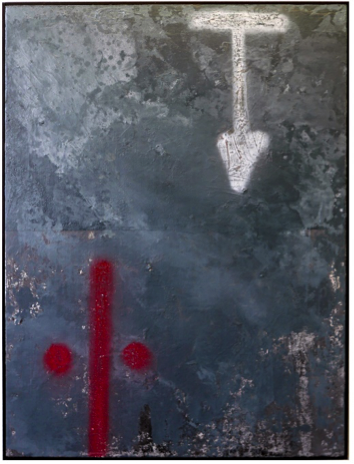
Mike Ballard, Surface I, 2015
In excess, graffiti letters or ‘tagging’ is seen by authorities as a provocation to criminal activity and attempts are made to remove it as soon as it appears. The chalky effect of Russell Maurice installation adheres to this transient nature of graffiti. His cheeky cartoon figures in MDF reclaim space where they can, their gagged snouts popping up out of their papery home sprawled across the floor. Saeio also reflects the temporary nature of graffiti in his video, Nolens Violence, a sequence in which the artist’s work is eradicated as soon as it is created.
Although graffiti is free from the confines of the architectural space it is restricted by the dingy fabric and textures of the street. Mike Ballard’s grey ‘urban hieroglyphics’ reference paving slabs, bearing the lumps of encrusted bubble-gum, layers of city grime and tarmacked joints left by utility companies. Ballard regards these as the positive effects of the continuous redevelopment and regeneration of the city. The ordered geometry and fuzzy lines of Six Paredes’ Futurismo Series appear the most optimistic, conveying utopia as a harmonious interaction between different cultures combining the universe in one common language.
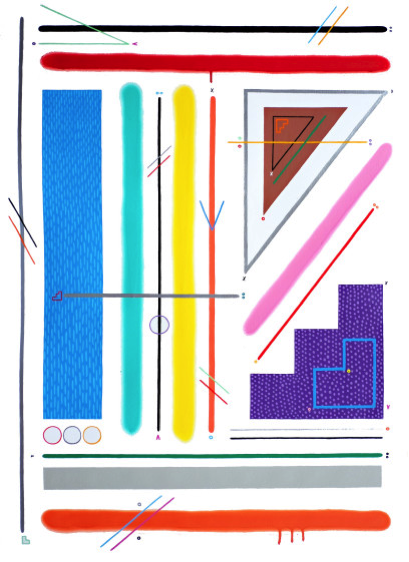
Sixe Paredes, Untitled 3 (Futurismo Series) 2015
Somerset House, Strand | London WC2R 1LA | March 3 – May 2, 2016 |
www.somersethouse.org.uk
To celebrate the 160th anniversary of both the National Portrait Gallery and Moscow’s State Tretyakov Gallery, the two institutions have organised a unique cultural exchange. Some of the main pieces of the Russian collection come to London, while the Tretyakov Gallery simultaneously hosts an exhibition of portraits of British icons from the National Portrait Gallery.
For the display in London, curators have put together a collection of portraits of Russia’s most eminent figures. Paintings of Russian artists, philosophers, composers, writers and patrons spanning 1867-1914 and highlighting an artistic golden age for the nation. The exhibition not only serves as an introduction to the key figures in Russia’s cultural history, it also provides an interesting insight into the development of Russian art. Combining Realist, Impressionist and Symbolist pieces, the collection gives credit to some notable Russian artists that are not so widely known in Britain.
Achievements of great Russian writers including Tolstoy, Chekhov and Dostoevsky, helped develop an extraordinary and rich cultural scene in Russia before the Bolshevik takeover in 1917, putting a tragic end to a cultural golden age. The display is a unique opportunity to explore Russian culture through the people who made it great, giving an idea and insight of the development of the country from a historical, creative and artistic perspective.
I was very pleased to notice that the selection of Tretyakov’s highlights is not only displaying works by famous Russian painters like Ilya Repin and Valentin Serov, but also introduces the remarkable Russian artists that are not very well known in the west. Nikolai Ge’s portrait of Alexander Herzen and Vasiliy Perov’s depiction of Fyodor Dostoevsky are very good examples.
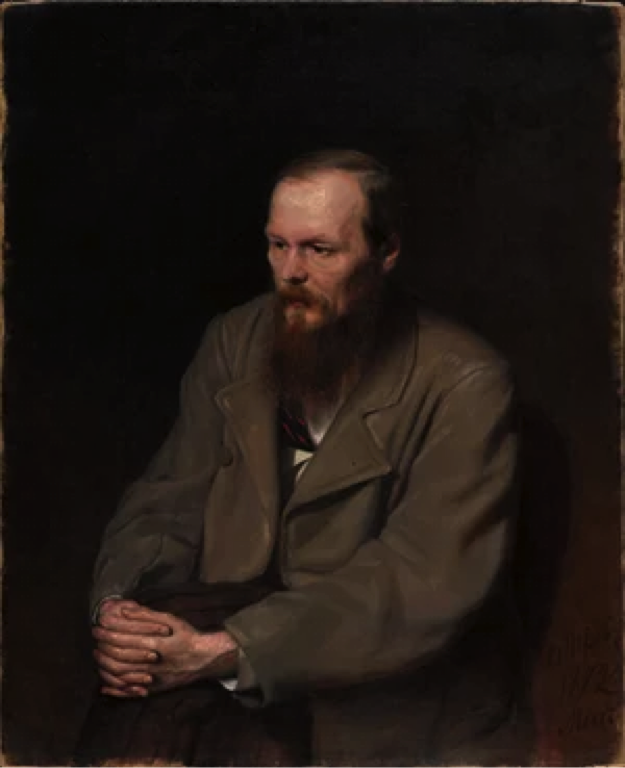
Fyodor Dostoevsky by Vasily Perov, 1872
The paintings are grouped by field and include portraits of writers, musicians and patrons, with each category reserving a few highlights. The theatre section focuses on a detailed and very realistic portrait of Chekhov and a large full-length painting of Maria Ermolova, one of the greatest actresses in the history of the Maly Theatre in Moscow, depicted by Valentin Serov. A section rightfully titled The Three Great Novelists, shows Dostoevsky, Tolstoy and Turgenev. Dostoevsky’s portrait certainly stands out, as it is the only likeness of the author to have been painted from life. The image has gained cult status in Russia and is still being produced on stamps and different merchandise.

Anton Chekhov by Osib Braz, 1898
Through the stories of each portrait, the painter and the person depicted, you can get a sense of the political atmosphere and the shifting dynamics within Russian society between 1867 and 1914. These artists of the age of Tolstoy share the sensitivity, honesty and the searching unease of the writers and composers they portray. Tatiana Karpova, Deputy Director of the Tretyakov gallery pointed out that “this art belongs not only to Russia but to all humanity.”
National Portrait Gallery, St Martin’s Place, WC2H 0HE London | March 17 – June 26, 2016 |
www.npg.org.uk
If you are anything like me, you’ve probably grown up watching the creepy old movies, reading Edgar Allan Poe, investigating old eerie buildings and going on ghost hunting adventures. For the lovers of fright, Guillermo del Toro has decided to share his spooky art collection with the world, and we couldn’t be happier! The director of Pan’s Labyrinth, Crimson Peak, Pacific Rim, and the iconic Hellboy has been assembling a vast collection of all things creepy: books, films, artworks, and various memorabilia, and storing them in what he calls his Bleak House – and it must be Halloween every day over there!
‘GUILLERMO DEL TORO TAKES HIS EERIE ART COLLECTION AROUND THE GLOBE’
Widewalls | March 21, 2016 | Ana Moriarty
LONDON
Now on:
Unexpected Eisenstein | GRAD
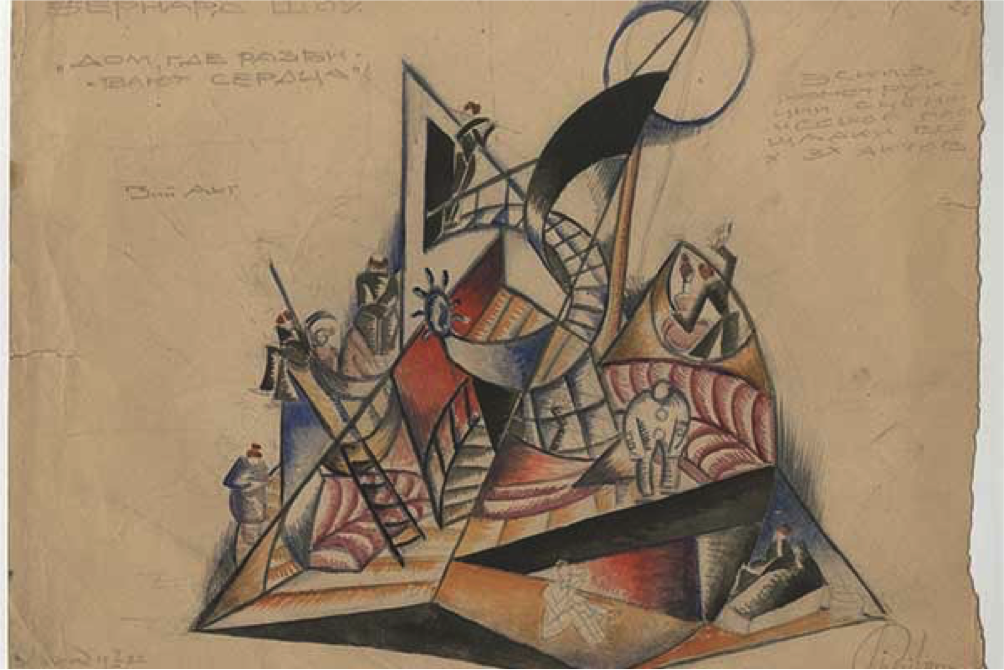
Unexpected Eisenstein—sketching the inspiration from revolution in Russia
Unexpected Eisenstein, an exhibition that sheds new light on the life and achievements of pioneering Soviet filmmaker Sergei Eisenstein. This immersive new exhibition invites audiences to consider Eisenstein beyond his cinematic achievements. Bringing together nearly seventy sketches, designs and printed materials, Unexpected Eisenstein offers a rare opportunity to see this varied and surprising collection of work and for the first time explores his often overlooked relationship with England.
3-4A Little Portland Street, London W1W 7JB | 17 February — 30 April | https://www.grad-london.com/whatson/
Now on:
Apostolos Georgiou: The Same Old Fucking Story | Rodeo
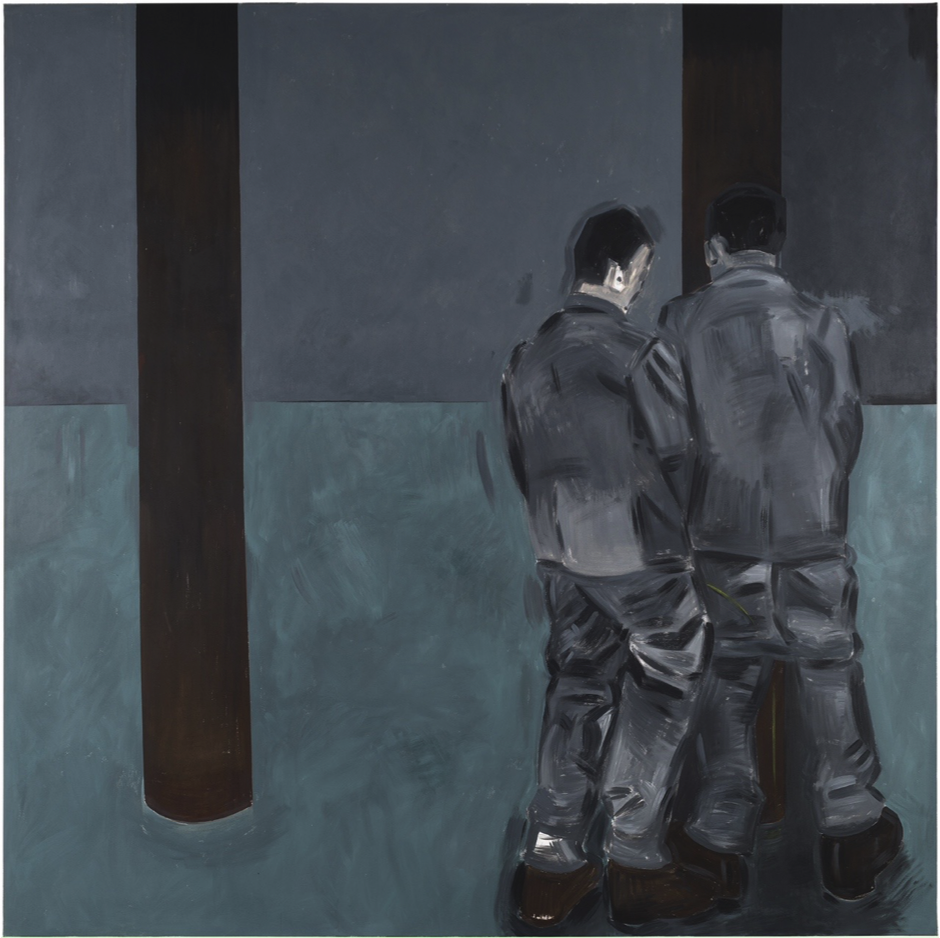
Apostolos Georgiou, Untitled, acrylic on canvas, 2016
Apostolos Georgiou’s large paintings dominate Rodeo’s tiny gallery space and adding to the aptly named title -The Same Old Fucking Story. Georgiou’s painting style is sketchy and blocky, the figures portrayed with thick, jittery outlines, blurring any detailed or identifiable features and creating rather sorrowful nameless figures. Although rather than having any distinct politically driven images, Georgiou sets stages for grey suited, white-collar workers, making subtle references no doubt to the ongoing economic and social crises in his home country of Greece.
123 Charing Cross Road, London WC2H 0EW | 19 February – 30 April | http://rodeo-gallery.com
Now on:
El Anatsui: New Works | October Gallery
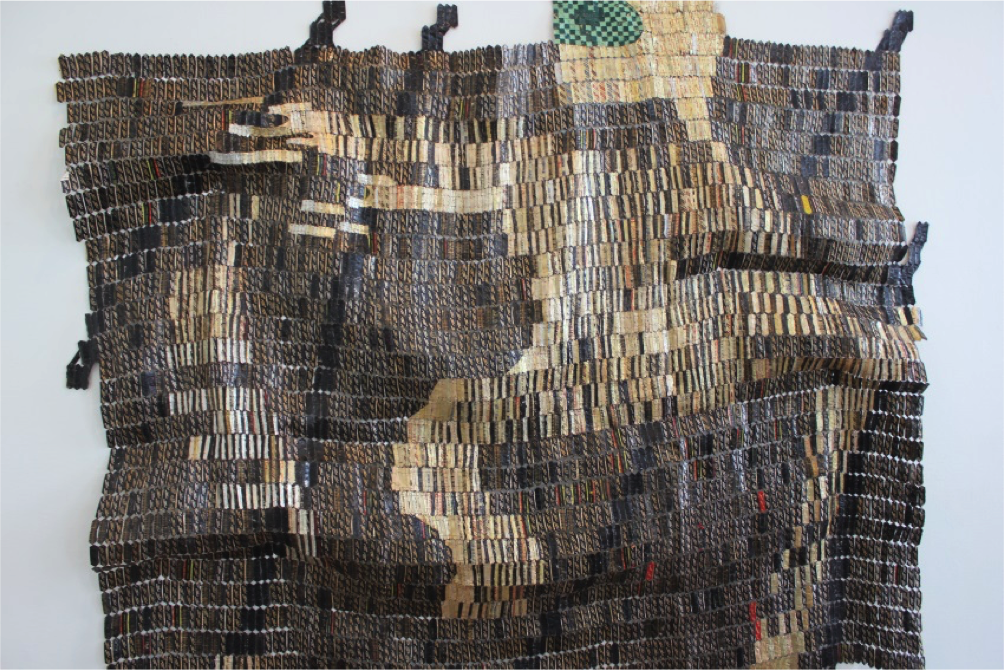
El Anatsui, Warrior, 2015. Aluminium and copper wire
40 year veteran Ghanaian artist El Anatsui is best known for his shimmering, contorted, sheet-like sculptures made of bottle tops sewn together with copper wire, which have clad the façades of buildings like the Royal Academy and Venice’s Palazzo Fortuny. His new work at October gallery, Russell Square although smaller in scale, the almost incandescent sculptures will be no less mesmerising.
24 Old Gloucester St, London WC1N 3AL | 27 January – 24 April | http://www.octobergallery.co.uk/index.shtml
Now on:
Sterling Ruby: Workwear | Sprüth Magers

Sterling Ruby, Installation view, Workwear: Garment and Textile Archive 2008 – 2016
Each time a piece of artwork is finished by Sterling Ruby, the multi-media artist who is well known for recycling scrap materials in his work, a new set of unique one-off garments are made as a conclusion to the project, indexing the clothes Ruby wears in the studio alongside the art itself. In this exhibition, from the fabrics that are hand-dyed and hand-treated in Ruby’s studio yard, to the exotic enzyme washes researched and sourced from LA’s rich garment production industry, these carefully crafted artworks in their own right are on display.
7a Grafton St, London W1S 4EH | 11 March – 09 April, 2016 | http://www.spruethmagers.com/home/
Now on:
Tori Wrånes: Drastic Pants | Carl Freedman Gallery
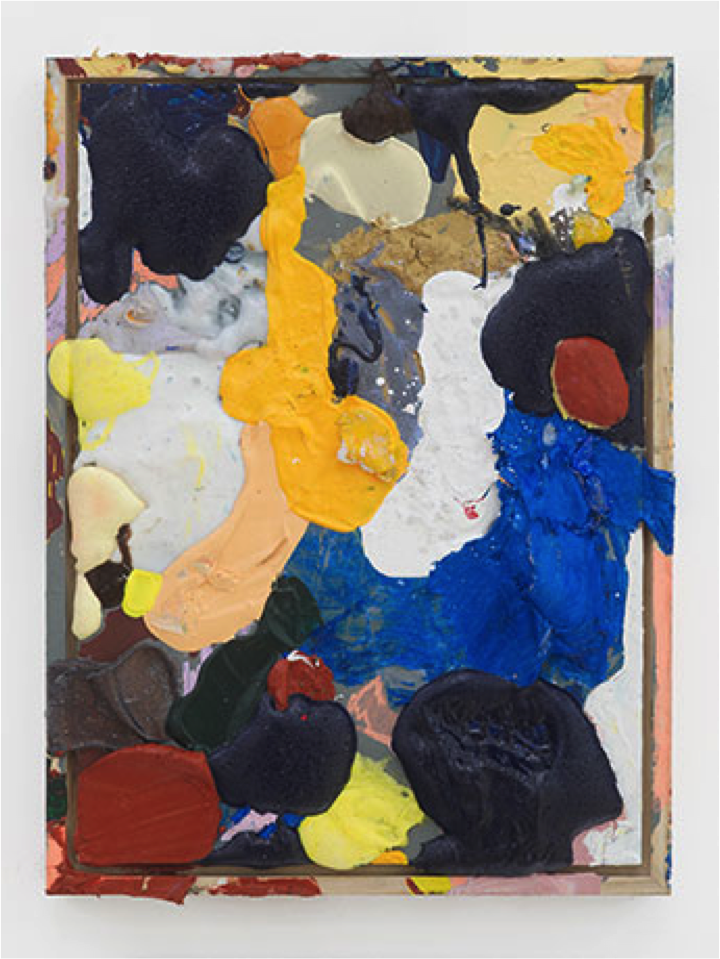
Tori Wrånes, Drastic Pants 2 (2016), Pigment, silicon, expanding foam, acrylic on poplar in ash frame
Winner of the ‘Best Exhibition Title of the Year’ award? With an array of prosthetics and props, Norwegian artist Wrånes creates performances that are often as funny as they are haunting. For her first major exhibition in London, she’ll be showing a number of floor- and wall-based works, including thick, blotchy abstract paintwork with mixed materials, suspended beanbags and floating ghost-like, headless figures.
29 Charlotte Road, London EC2A 3PB | 25 February – 02 April, 2016 | http://www.carlfreedman.com
NEW YORK
Now on:
Hedda Sterne: Machines 1947-1951 | Van Doren Waxter
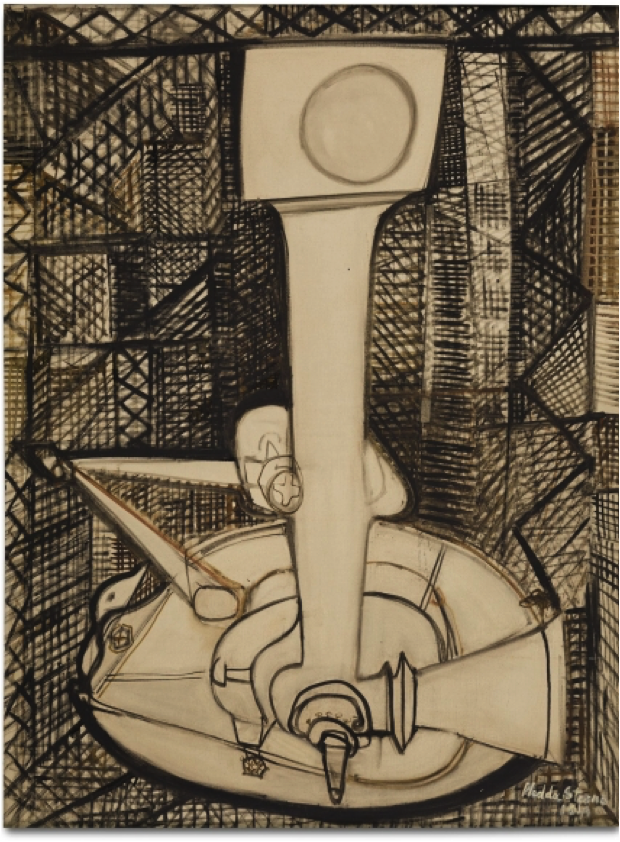
Anthropograph #19, 1949, Oil on linen
Van Doren Waxter is pleased to present Hedda Sterne: Machines 1947 – 1951, an exhibition of mid-century paintings and works on paper by this preeminent figure of the American post war period. Hedda Sterne began her “Machines” series in 1947 after encountering farming machinery on a trip to Vermont. The result: Anthropographs, abstracted machines with a humanlike nature. Sterne, a recent emigre from Romania, was deeply affected by the cultural and aesthetic shift she discovered in the United States.
23 E 73rd St, New York 10021 | 09 March – 28 April, 2016 | http://www.vandorenwaxter.com
Now on:
Unfinished: Thoughts Left Visible | The Met Breuer

Alice Neel, James Hunter Black Draftee, 1965. oil on canvas
The question, “When is a piece finished?” Is addressed in The Met Breuer’s inaugural show using juxtapositions of ‘Old Master’ works with examples of modern and contemporary art. The show presents artworks that were clearly left incomplete alongside others that are deliberately unfinished as an interrogation of the artists’ creative processes. The unfinished has been taken in entirely new directions by modern and contemporary artists, among them Janine Antoni, Lygia Clark, Jackson Pollock, and Robert Rauschenberg, who alternately blurred the distinction between making and un-making, extending the boundaries of art into both space and time.
945 Madison Ave, New York | until 4 September | http://metmuseum.org
Now on:
Rachel Harrison: Perth Amboy | Museum of Modern Art
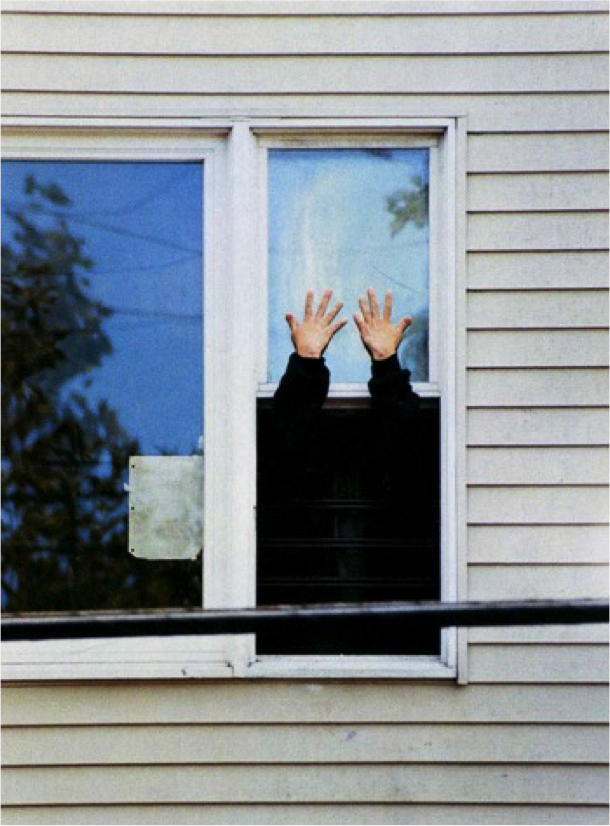
Rachel Harrison, Untitled (Perth Amboy), 2001 Chromogenic print
Named after a town in New Jersey where an apparition of the Virgin Mary was said to have appeared on the window of a two-story house, Rachel Harrison’s room-sized work Perth Amboy exemplifies a cross-disciplinary approach to making art. The work comprises 21 photographs, individual sculptural assemblages, and an open-ended labyrinth made from cardboard.
11 W 53rd St, New York 10019 | until 5 September, 2016 | http://moma.org/
Now on:
Raoul De Keyser: Drift | David Zwirner
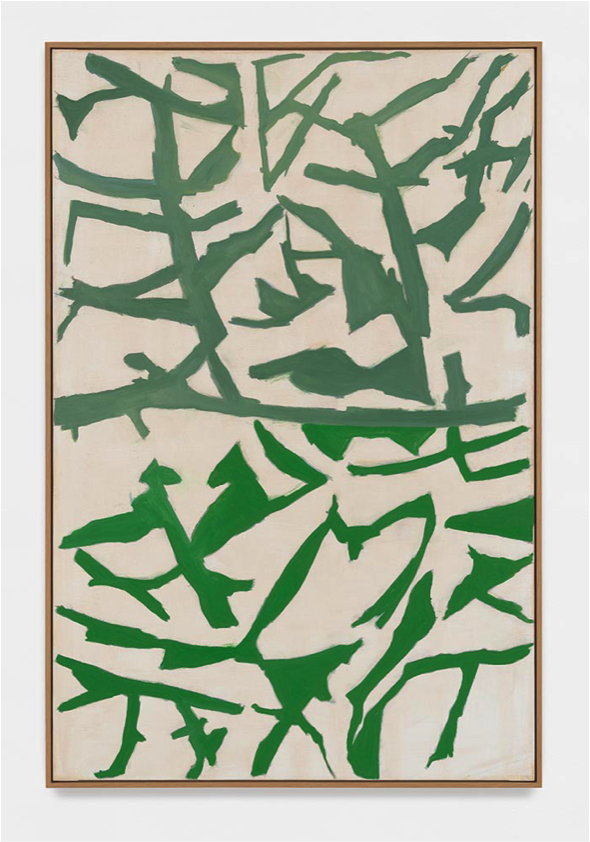
Raoul De Keyser, Retour 2, 1999. Oil on canvas
Raoul De Keyser: Drift is organized around a group of twenty-two works completed shortly before his death in October 2012, and known as The Last Wall. Together, they revisit some of the major subjects that occupied the artist throughout his nearly fifty-year long career, including the landscape of the Belgian lowlands where he grew up and lived his entire life and the inconspicuous things close at hand. Shown together for the first time in David Zwirner London last year, these paintings, will be accompanied by a careful selection of works from the 1990s onwards that are likewise representative of these subjects.
537 W 20th St, New York City 10011 | 18 March – 23 April, 2016 | http://www.davidzwirner.com
Now on:
Carrie Moyer: Sirens | DC Moore Gallery
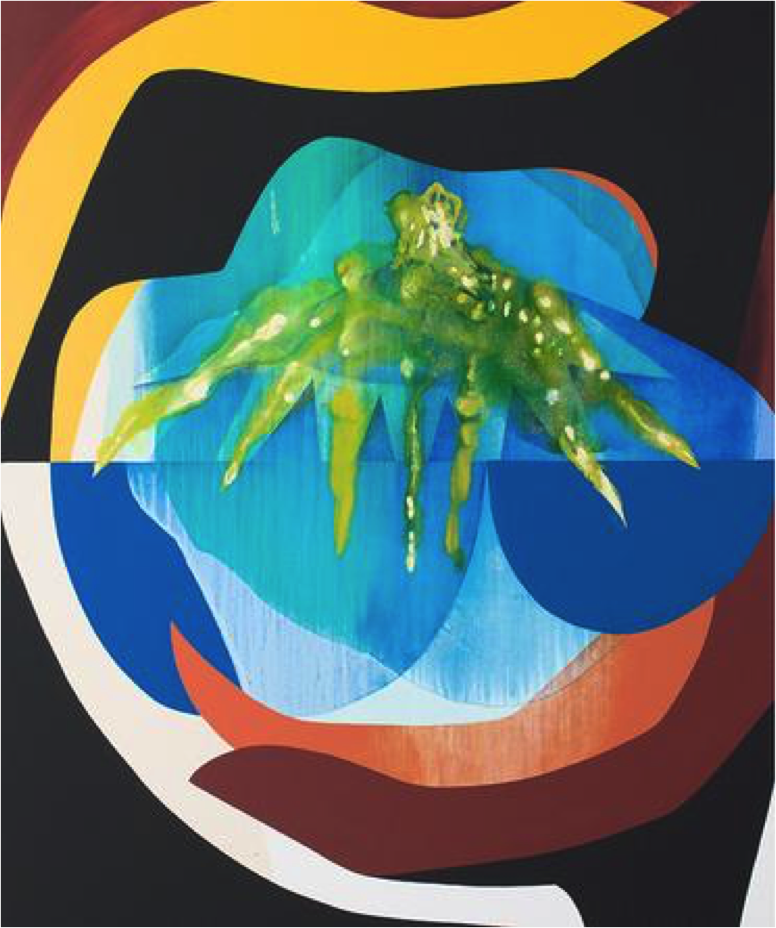
Carrie Moyer, The Green Lantern, 2015. Acrylic and glitter on canvas
Rife with visual precedents, Moyer’s compositions reference Color Field, Pop Art and 1970s Feminist art, while proposing a new approach to fusing history, research and experimentation in painting. Sirens marks Carrie Moyer’s first exhibition with DC Moore Gallery and her sumptuous paintings on canvas explore and extend the legacy of American Abstraction while paying homage to many of its seminal female figures among them Elizabeth Murray, Helen Frankenthaler, and Georgia O’Keeffe.
535 West 22nd Street, second floor, New York | 18 February – 26 March, 2016 | http://www.dcmooregallery.com
Many of us may have preconceptions about how an Art Collector’s apartment would look and how they would choose to display art in their personal space. Whilst this apartment is home to some exquisite art, it is also a functional family residence where the boundaries between living and exhibiting blend smoothly and in a subtle way.
‘An Art Collector’s Apartment in São Paulo, Brazil’
Yatzer | March 17, 2016 | Loukas Angelou
At the ICA this spring, Betty Woodman takes center stage with her playful works. One of the most important contemporary artists working with sculpture, painting and ceramics, Woodman presents a vibrant collection of mixed media created within the past ten years, including new pieces made especially for the ICA. The exhibition’s title, Theatre of the Domestic, relates quite comfortably to Woodman’s distinctive exploration of domestic space. Combining wallpaper, vases and other domestic objects seems to subvert how the home is occupied and used, discovering decorative forms and their purpose within the domestic space.
Betty Woodman has been working and creating with clay for almost 70 years, since she took a one-off pottery class in high school. “I still have the naive belief that having beautiful things around you might make you a better person,” she shares. Bringing together vases, paintings and drawings in theatrical dialogue, the Institute of Contemporary Art presents the opportunity to experience and interact with Woodman’s fascinating creations. What I personally love about Betty Woodman, her work doesn’t tease or provoke, it just puts a happy smile on your face as you walk through her wonderful ceramic artworks.

Betty Woodman: Theatre of the Domestic at the ICA. Photography by Mark Blower
The artist playfully combines two-dimensional paintings and three-dimensional vessels, breaking the boundaries of form. A series of experimental “wallpapers” with over three hundred glazed ceramic fragments, leftover from the vessel making process, prove just that. The abstract patterns seem to flow across the walls, almost growing through the space.
Painting, particularly in recent years, plays a key role in the work of the artist. Inspired by Egyptian art, Greek sculpture and Italian Baroque architecture, Woodman’s colourful drawings on handmade paper or canvas combine graphite, ink and lacquer with wax. The show’s largest piece is the four-part painting taking an entire gallery wall, titled The Summer House. It depicts a Pepto-Bismol pink table full of pots and plates and vases, recalling Woodman’s vibrant Manhattan loft.
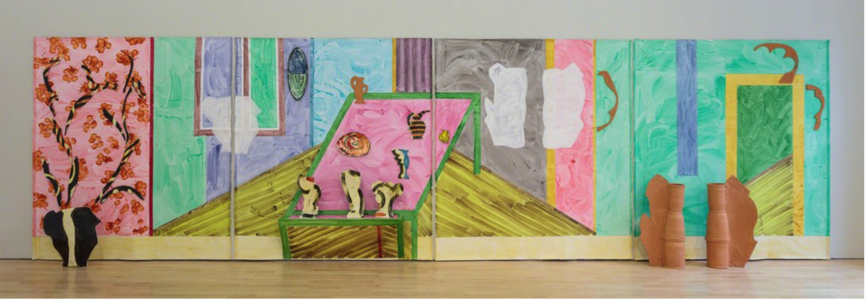
Betty Woodman: Theatre of the Domestic at the ICA. Photography by Mark Blower
Another important part of the artist’s collection, ceramic vases, are displayed in different locations, some directly on the floor and others one the platforms. Woodman has been experimenting with vases for many years, giving them new forms and meanings. Berry Woodman’s vase can be a vessel, a human body, a metaphor or an art-historical reference. Circle around each piece and the surface of the vase will undulate and veer – one of Woodman’s creative tricks.
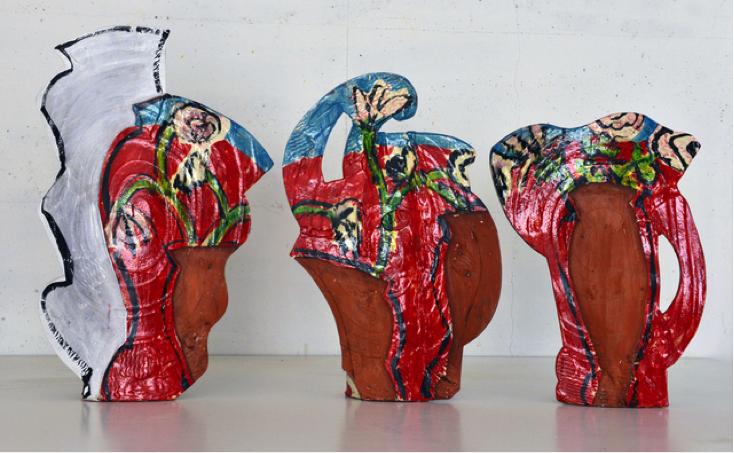
Betty Woodman: Theatre of the Domestic at the ICA. Photography by Mark Blower
All works by Betty Woodman relate to her ceramics, their decorative design, and unusual use of various media that can be seen as a way of exploring her inner sensibility as an artist. Cheery palette of colours and quirky forms throughout the show make it easy to enjoy and admire the artist’s work in a pleasant, effortless way.
Institute of Contemporary Arts, 12 Carlton House Terrace SW1Y 5AH London | February 3 – April 10, 2016 | ica.org.uk
[By Oliver Roche]
LONDON
Now on:
Renee So | Kate McGarry
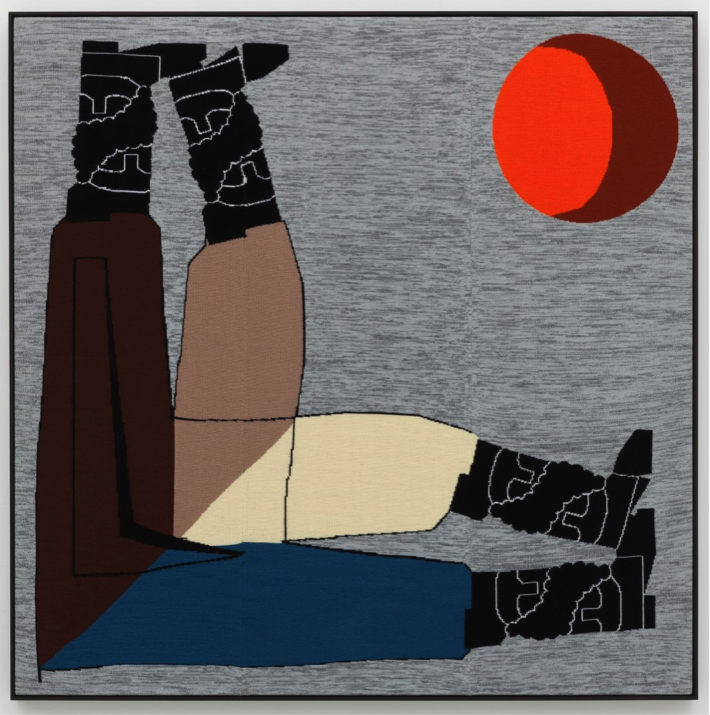
Renee So, Sunset, 2016, knitted linen and synthetic fibre
Shoreditch town’s Kate McGarry exhibits the Hong Kong born, Melbourne raised, Londoners’ third solo exhibition at the gallery. A collection of new tapestries and ceramics repeating motifs such as disconnected limbs. Drawing from the traditions of antiquity and historical portrait busts, spherical curls of Assyrian beards and lit cigarettes play across both tapestries and ceramics. Elephants feet, anthropomorphic cocktail glasses and giant cigarettes are suggestive of dream logic, the golden age of American advertising and upturned moments of leisure.
27 Old Nichol St, London E2 7HR | 16 March – 16 April | http://www.katemacgarry.com/
Now on:
Santiago Montoya | Halcyon Gallery
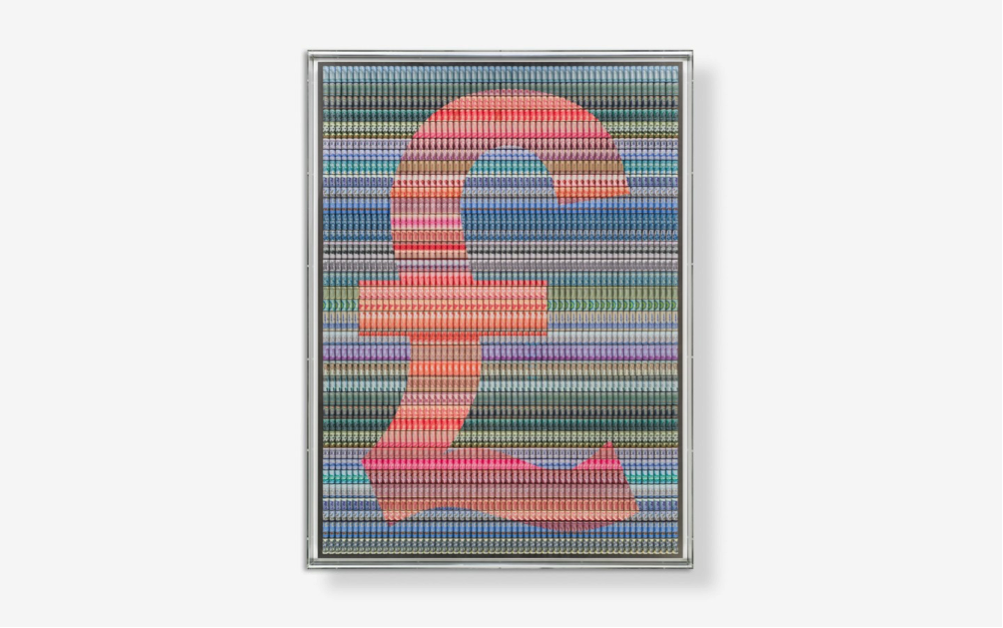
Santiago Montoya, Money Talks, 2016
Contemporary Colombian artist, Santiago Montoya gives us Money Talks, his exhibition at Halcyon Gallery, West End. This brand new body of work is part of an ongoing exploration into currency, history and socio-political issues. Combining the pop vocabulary of Warhol and a multitude of rolled international banknotes, Montoya uses the world’s leading currencies as his aesthetic arena.
144-146 New Bond Street, London W1S 2PF | 16 February – 2 April | http://www.halcyongallery.com/
Now on:
Armand Boua: Les Zinzins | Jack Bell Gallery
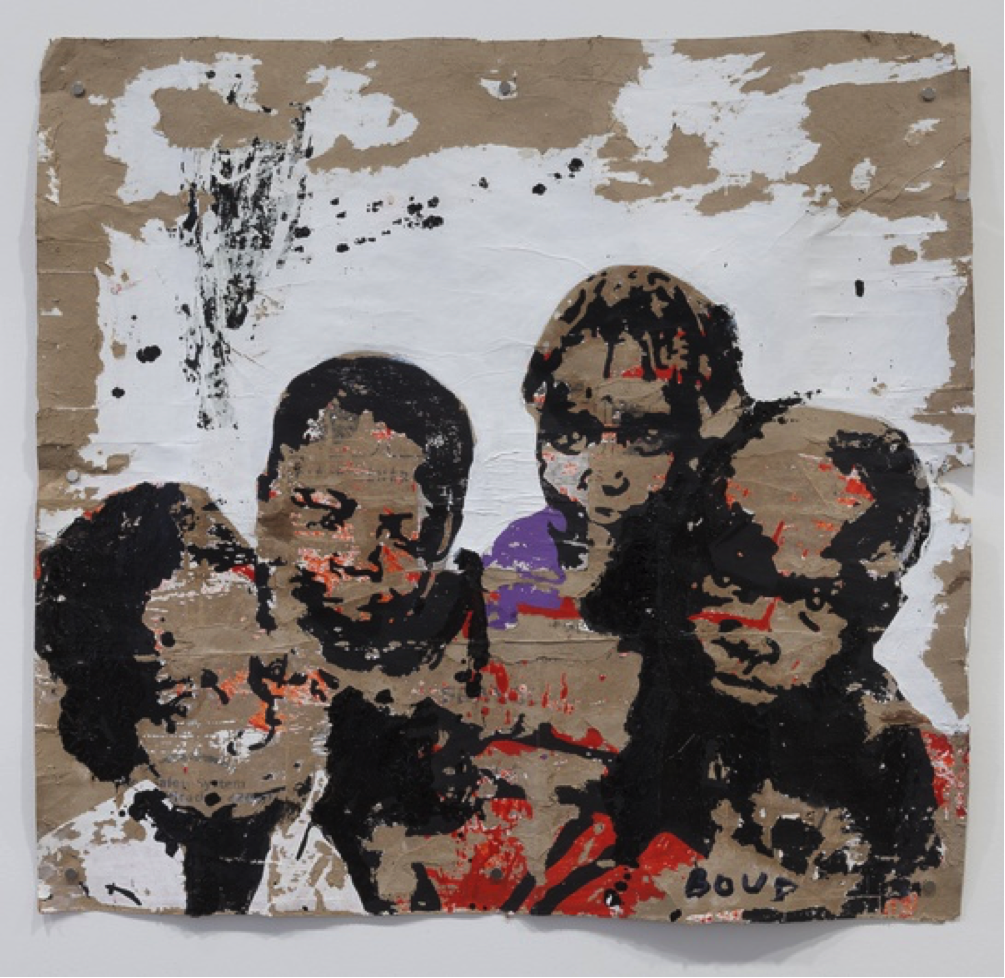
Armand Boua, Les Zinzins, 2016
The street kids of his hometown are the subjects of this Ivory Coast artist’s paintings. Built up in textured layers on scrap cardboard, Boua’s works may feel rough-handed, but the socio political issues of West Africa are handled with sensitivity
13 Mason’s Yard, St. James’s, London SW1Y 6BU | 4 March – 18 March | http://www.jackbellgallery.com/
Now on:
Harmony Korine: Fazors | Gagosian Davies St
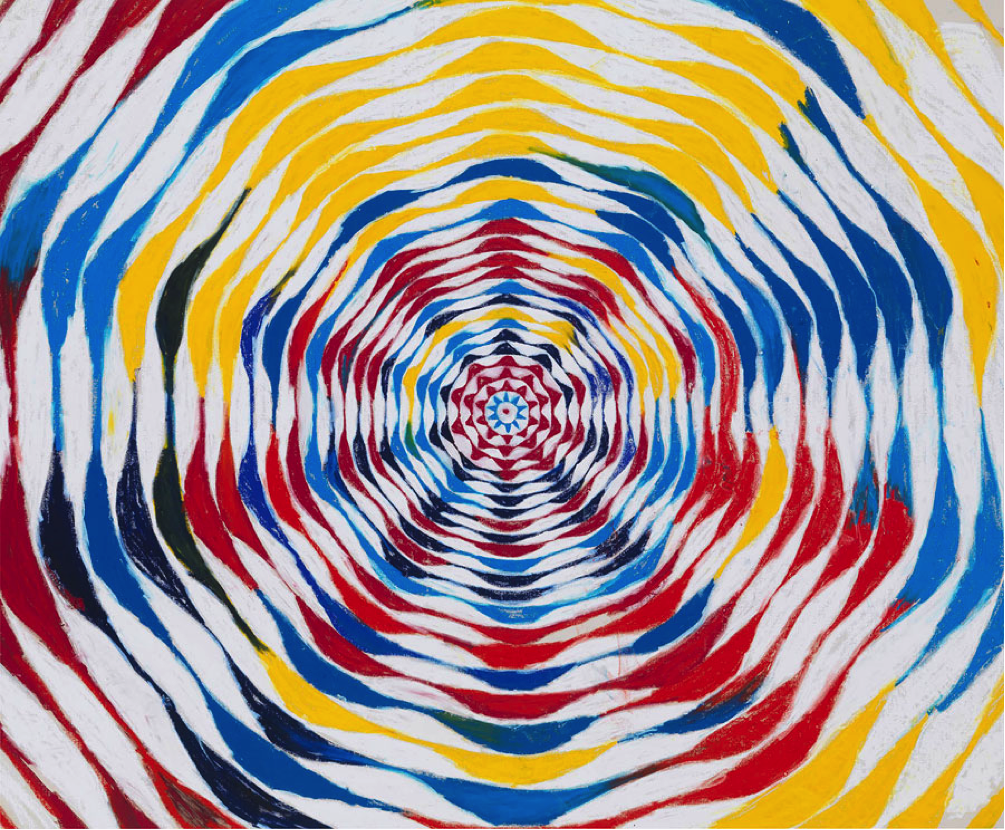
Harmony Korine, Pro Stek Circle, 2015, oil on canvas
Large-scale, colour-filled, concentric circles – inspired by sun motifs from the 60’s and 70’s – make up Korine’s ‘Fazor’ series. Paintings alluding to the phaser effect, these images are symbolic of oscillating sound and hypno-psychedelic effects.
17-19 Davies Street, London W1K 3DE | 15 March – 24 March | http://www.gagosian.com/
Now on:
Julian Charriére: For They That Sow the Wind | Parasol Unit
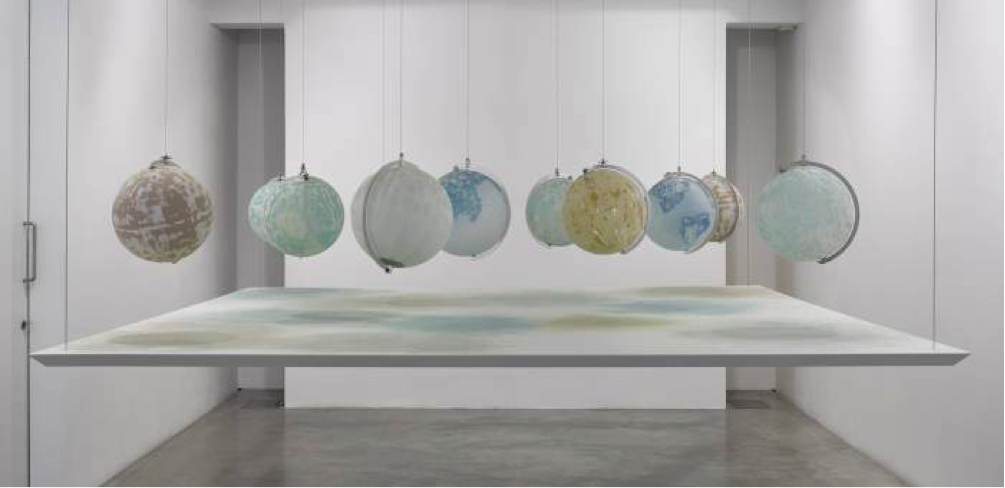
For They That Sow the Wind, Installation view, 2016
Parasol Unit foundation for contemporary art showcases the first solo exhibition in the UK by French-Swiss artist, Julian Charriére. Including sculpture, documented performance, installations, photographs and film – Much of his work is concerned with time, the continuous cycle of past, present and future, as well as sudden and gradual physical transformations that have occurred naturally or due to human activity. Creating works while exploring ecological and environmental issues in specific locations, Charrière examines how humanity interrelates with the natural order.
14 Wharf Road, London N1 7RW | 15 January – 23 March | http://www.parasol-unit.org/
NEW YORK
Now on:
Anna Ostoya: Slaying | Bortolami

Anna Ostoya, Slain Abstraction (1), 2016 Oil on canvas
Bortolami is pleased to announce Slaying, Anna Ostoya’s third exhibition at the gallery. In her new paintings and photomontages, the artist deploys Artemisia Gentileschi’s iconic work, Judith Slaying Holofernes, as an image of violence inherent in art and in life. The original painting depicts the story of Judith, a Jewish widow who saves her people besieged by the Assyrian army. With the help of her maidservant, she plies Holofernes, the army general, with alcohol and then beheads him in his drunken state.
520 W 20th Street, New York, NY 10011 | 25 February – 23 April | http://bortolamigallery.com
Now on:
Nicola Tyson | Petzel Gallery

Nicola Tyson, Red Self Portrait, 2002, Acrylic on paper
A British artist working in New York, Nicola Tyson is sometimes compared to Francis Bacon as both artists pursue a gnarly Expressionistic style of figurative painting in which the human form becomes almost unrecognizable through warping, twisting and other depredations. Tyson, however, is more of an abstractionist, investing much her of energy in color, though she works just as compellingly in black and white. This show offers some of both with works on paper in acrylics, as well as graphite.
456 W 18th Street, New York 10011 | 2 March – 23 April | http://www.petzel.com
Now on:
Tim Wilson: Something Rather Than Nothing | Sardine

Tim Wilson, Something Rather Than Nothing, 2016
Something Rather Than Nothing consists of a grouping of Wilson’s recent paintings of small floral still lifes and large-scale abstractions. Due in part to their size, the all-encompassing fields of shifting colour in the larger works envelop one’s body within a center-less universe, recalling the well-traveled histories of abstraction and the color field. This effect is undercut by the inclusion of small, deftly rendered flowers that invite an interior contemplation in the even longer western tradition of nature morte.
286 Stanhope Street, Ground Floor, Brooklyn, New York 11237 | 5 March – 10 April | http://sardinebk.com
Now on:
Genesis Breyer P-Orridge: Try to Altar Everything | Rubin Museum of Art

Try to Altar Every Thing, 2016
Try to Altar Every Thing is a new, site-specific artwork by Genesis Breyer P-Orridge that incorporates small personal offerings from visitors. These objects will be arranged and rearranged throughout the gallery by the artist for the length of the exhibition. The installation enacts the concepts of devotion, exchange, and community that are at the heart of the artist’s multidisciplinary practice.
150 West 17th Street, New York, NY 10011 | 11 March – 1 August | http://rubinmuseum.org
Now on:
Global/Local 1960-2015: Six Artists from Iran | Grey Art Gallery

Parviz Tanavoli, Last Poet of Iran, 1962
Comprising of paintings, sculpture, drawings, mixed-media installations, and video, Global/Local 1960–2015: Six Artists from Iran features works by three generations of Iranian artists born between 1937 and 1982. The exhibition presents some ten works each by six artists—Faramarz Pilaram, Parviz Tanavoli, Chohreh Feyzdjou, Shiva Ahmadi, Shahpour Pouyan, and Barbad Golshiri—examining their individual artistic practices through shared aspects of their Persian heritage, such as ornamentation, poetry, architecture, and Sufism.
100 Washington Sq East, New York | 12 January – 2 April | https://greyartgallery.nyu.edu
Encumbered with big doleful heads and spindly legs, Emma Talbot’s melancholy characters narrate the recollections and missed opportunities along her life’s journey. Unravel These Knots comprises a selection of her ink drawings, screen printed textiles and hand-made objects which display the content of her dreams, her subconscious self and sexual fantasies. Her scenes, sometimes presented in the manner of a storyboard, depict her relationships within domestic scenarios against the backdrop of her Northern upbringing in Newcastle. Her lithograph, Vanishing Point, exemplifies the linear but also cyclical nature of her work in which she conveys the contents of her mind at any given moment. She prefers to leave the faces of her characters blank in order to suggest that elements of her own personal experiences might also reflect those of others.
Freud’s consulting room was furnished in the manner of a domestic interior in order to relax his patients during psychoanalysis. He attempted to reconstruct the interior in detail at his study in Maresfield Gardens in response to his sadness in leaving his home at Berggasse, Vienna after fleeing the Nazis in 1938. Within a plethora of worn rugs and faded velvets, the sightless eyes of Freud’s treasured Egyptian relics loom from this now darkened room. Sometimes yellow, turquoise or charcoal brown, the colours of his jaded book jackets are picked up in Talbot’s carpet drawing, Unravel These Knots, a distressed and patched up piece of decorative motifs and despondent messages enlivened here and there with Pharaohs’ gold. Her storyboard of sexual fantasies is strewn like a ‘Jackie mag’ on Freud’s legendary couch like the remnants of a therapy session, an urgent tale of grab-it-where-you-can.
In Anna Freud’s room sits Intangible Things: Dreamer, a stuffed ‘head’ disguised as a cushion; its vastness an incongruity on a child’s couch. Tightly packed like Louise Bourgeois’ Femme Couteau, its form conveys the state of passivity during psychoanalysis. Separated from its mind, lies a heap of dark tubular forms suggestive of the restless positioning of legs during treatment as a patient might search for its missing ‘body’ or childhood memory.

Emma Talbot, Intangible Things: Dreamer. Photo: Andy Keate
In Freud’s essay, Screen Memories which in part inspires Talbot’s work for this exhibition, Freud emphasizes the importance of analysing the fragments of dreams rather than viewing them in their entirety. A vivid silk screen print presents fragmented scenes from Talbot’s early life which envelop Freud’s dining room wall in waves of psychedelic colour. At odds with his traditional Bavarian furniture, the print’s jazzy hues appear to characterise the many personalities he dealt with on a daily basis. In Talbot’s troubled world, figures precariously walk along walls, make love hastily above banks of dahlias or desert the family home, bag in hand. Behind these scenes, her superstitions are symbolized by a fragmented window pane as a portent to further events.
Where: Freud Museum, 20 Maresfield Gardens, London NW3 5SX
When: 10 February – 10 April 2016
Website: www.freud.org.uk
The way we view art is constantly evolving as artists and curators strive to create impactful exhibitions that challenge the viewer. In London, a city completely saturated with galleries, glimmers of innovation are found in exhibitions that subvert conventional models of curating. The stuffy gallery space attracts a niche crowd of art enthusiasts, some as institutionalised as the static white gallery walls. A factor that is fuelling the art community’s desire to make the arts ‘more accessible’ in hope of diminishing the surrounding pretence. In my eyes the gallery space is arguably as important as the art itself and frequently there is an overarching static quality to London-based exhibitions.
In opposition to this rigid template for the gallery space comes a stream of artists and curators attempting to break the sanctity of the sited exhibition. One such example can be seen in the work of Vitrine, a gallery that has artist experimentation and development at its core. The programme of exhibitions presents site-specific installations that seek to undermine the permanence of traditional gallery spaces.
A theme at the centre of Jamie Fitzpatrick’s work, an emerging artist represented by Vitrine, as he disrupts not only the nature of how his work is viewed but also symbols of social authority. (Loudly) chomp, chomp, chomp is a refreshingly energetic solo exhibition anchored by absurdist theatre and the tradition of ‘Punch and Judy’ as part of a satirical exploration of indecency in the face of authority.
Fitzpatrick was not limited by the 16-metre vitrine in which his work is exhibited, with the comical wax figures appearing completely absurd as part of destabilising social status and the totems of authority. The grotesque, cartoon-like waxworks are set against the backdrop of a three-part play written by Fitzpatrick, combining his growing passion for writing, whilst injecting a strong narrative element into his work.
Vitrine exists to support artists such as Fitzpatrick, who used the platform to continue to develop his artistic practise. The exhibitions are viewable 24/7 and seek to stretch beyond the parameters of the space. The madness of Fitzpatrick’s messy, comical work, that features motorised figures, seeps into the surrounding public domain, placing transgression at the centre.
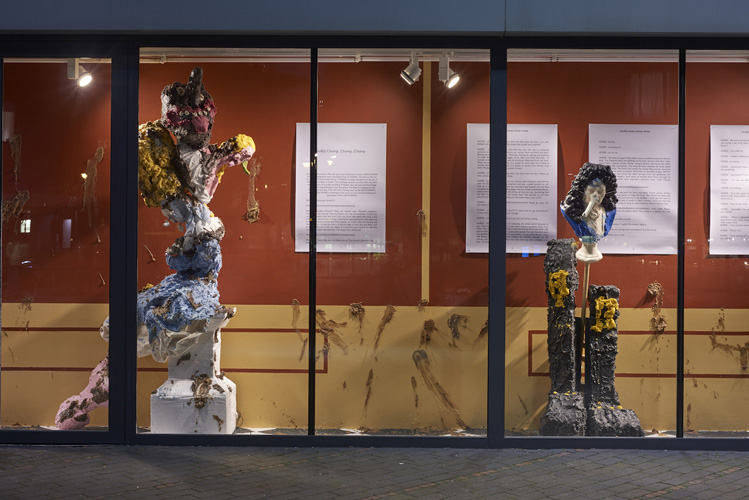
Courtesy VITRINE. Photographer Jonathan Bassett. Jamie Fitzpatrick, The Gentleman (detail), 2016
Located VITRINE, 15 Bermondsey Square, SE1 3UN London
Until 9 April 2016
http://www.vitrinegallery.com/
Mark Wallinger’s first exhibition in London in ten years has opened at Hauser & Wirth, displayed prominently in both of its Savile Row galleries. ID is inspired by Sigmund Freud’s work and his terms. Id, as the primitive and instinctive component of personality, ego – a part of id that has been modified by the external world, and finally superego – the values and morals of society learned from others. In his show, Wallinger presents new paintings, sculptures, photographs and multi-media works that explore the position of the self within society.
The works are thematically grouped around the varying aspects of the mind, opening with a playful recreation of Michelangelo’s famous painting of Adam and God. The piece titled Ego features Wallinger’s own hands in a pair of coincidental iPhone photographs, that he tacked together on his kitchen wall. In Wallinger’s representation of the famous painting, he is, obviously, both Adam and God.

Installation view. Ego, 2016 © Publicity image
The key of the show is a monumental series of 17 works that grew out of Wallinger’s self-portraits, that he called ID. Black on white canvas and what seems perfectly symmetrical at first glance, paintings immediately suggest the resemblance to giant Rorschach’s inkblots and brain scans. Made without brushes, Wallinger painted them using his own body and paint covered hands, working over canvases specially made to his body’s dimensions, recalling the bilateral symmetry of Leonardo da Vinci’s Vitruvian Man.
‘The paintings are made with instinct, sometimes blindly, intuitively and/or in a dialogue,” Wallinger explains in the exhibition catalogue, “as human beings, we operate between our instinctual urges, our attachment to our identities, and the ways in which we judge ourselves as members of a certain culture”.
In the same way that Leonardo da Vinci advised artists to stare at a wall until their imagination could fill in the details, Wallinger leaves it to the viewers to decide what it is exactly they see in his paintings. It is a great exercise to recognise parts of our consciousness that are unknown to us, yet crucial in the way we construct our personalities and interact with people around us.
One of the video works, Orrery, is a film about the Oak tree in Fairlop, near where Wallinger was born. The film was made with an iPhone video camera, tacked to the driver’s side window, capturing the tree that had stood in Hainault Forest for centuries.
Wallinger has been filming the Oak tree at the centre of the roundabout and the surrounding area for a whole year. Presented on four screens it encourages the viewer to see the work with the same motion as a car has been going round and round. By naming this work Orrery, a model of the solar system, Wallinger makes a comment on our personal and national identity, history and society by emphasising and exaggerating every day moments that can otherwise pass us by.
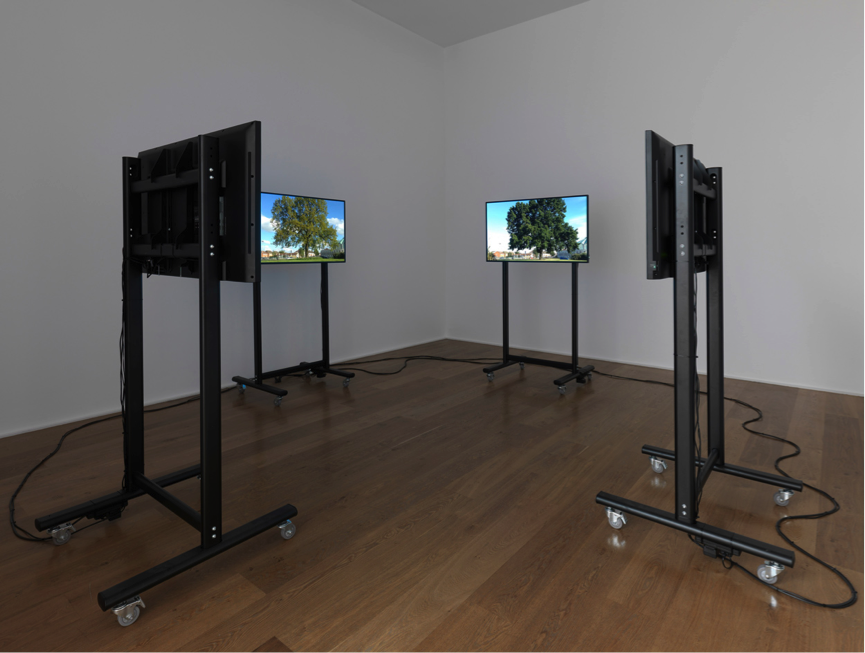
Installation view. Orrery, 2016 @Publicity image
The final piece, Superego, represents Wallinger’s latest sculptural work. It features a mirrored version of the revolving Scotland Yard sign as a symbol of an all-seeing, ever-present eye that controls our behaviour, just like Superego does.
“The superego acts to perfect and civilise our behaviour,” says Wallinger. “It works to suppress all unacceptable urges of the id and struggles to make the ego act upon idealistic standards rather than upon realistic principles. The New Scotland Yard sign is a brand, a logo, the seat of authority, the all-seeing eye, omnipresent and omniscient.”
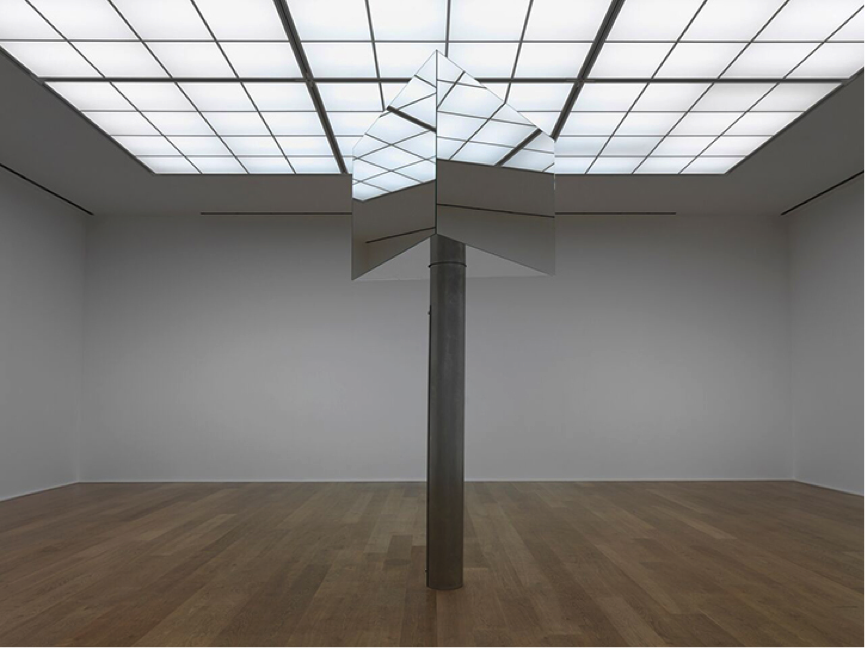
Installation view. Superego, 2016. @ Ken Adlard
In 1923, Sigmund Freud presented an important idea and multiple aspects of the human psyche that fuel our basic, instinctual drives – id, ego, and superego. Mark Wallinger’s new exhibition is about the artist looking inwards, exploring himself and his place in the world. It raises many questions regarding our personal behaviour, place within society, and the way we relate to ourselves, making me think, how our actions and thoughts are influenced by the world around us.
Hauser & Wirth, 23 Savile Row, London, W1S 2ET | 26 Feb – 7 May 2016 | www.hauserwirth.com
Valeria Napoleone does not live in a house like yours – or mine, for that matter. Behind the classical walls of the Italian-born art collector’s leafy Kensington abode, lays an expansive collection of contemporary masterpieces. The ground-floor sitting room, for example, reveals a startling selection of works by pioneering female artists such as Lily Van der Stokker, Goshka Macuga and Guan Xiou – all displayed with loving causality, as though to reassure guests (and certainly her three children: Federico, Gregorio and Letizia) that this is a family home, and not a gallery.
‘Valeria Napoleone: Foremost Collector of Modern Female Art’
Another | March 8, 2016 | Natalie Rigg
LONDON
Now on:
Victoria Arney, Ian Chamberlain, Liz K. Miller: Timeline | Bearspace

Ian Chamberlain, Transmission II, 2016
Finishing this week, Deptford’s Bearspace Gallery hosts a group of works by the British artists exploring the ways that contemporary etchers utilise this historical process, often combining graphic, symmetry and concept to represent space and form in temporal and evocative ways. Each etching is taken from a form of architecture, be it within cities or our natural surroundings and the result in all three artists works are finished pieces that denote the process, both of the artist’s area of investigation and method of production.
Where: T152 Deptford High Street, London, SE8 3PQ
When: 29 January – 4 March
Website: http://www.bearspace.co.uk
Now on:
Contemporary Visions VI | BEERS London
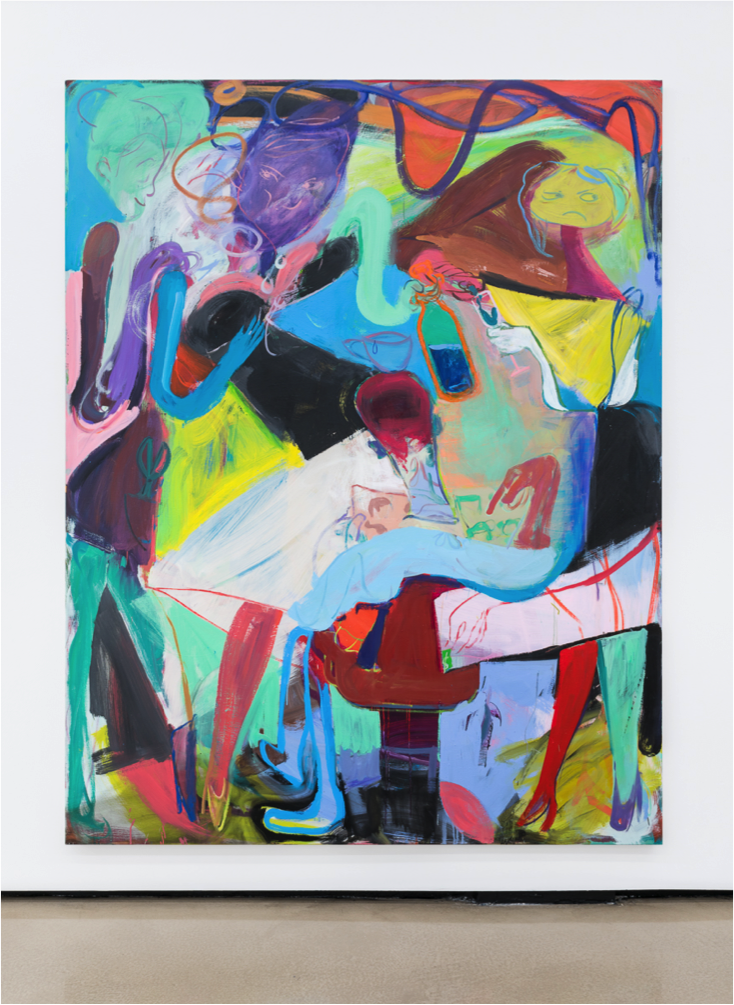
Jonathan Lux, Dreamette, oil on canvas, 2015
Featuring ten emerging artists, Contemporary Visions group exhibition has sought to identify current trends in contemporary art and in its sixth year, the show once again features more distinct promise. Comprising of abstract paintings, installation art with sculptures and mixed media that is captivating in every aspect. Jonathan Lux’s ‘Dreamette’ stands out as well as Mikey Cook’s works that use rows of perfectly straight lines intersected by curved and soft shapes to emphasise space and different objects.
Where: 1 Baldwin Street, London EC1V 9NU
When: 19 Feb – 19 March
Website: http://www.beerslondon.com
Now on:
Channa Horwitz | Raven Row

Channa Horwitz, Flowing 1, ink on paper, 1987
Channa Horwitz, one of the pioneers of late 60s and 70s Californian minimalism and close friend/contemporary of Sol LeWitt. This exhibition reconfigures the first survey of Horwitz’s work at KW Institute for Contemporary Art, Berlin, in 2015 and although largely overlooked over the course of her life, Horwitz quietly pioneered her own brand of West Coast minimalism – often deploying rules, numbers and structures in conjunction with colour codes, Horwitz used this system to depict time and movement. Her outstanding series titled Sonakinatography can be understood in terms of notation, for instance for music or composition.
Where: 56 Artillery Lane, London E1 7LS
When: 10 March – 1 May
Website: http://www.ravenrow.org
Now on:
Annie Lapin: How to Bury Your Stuff | Josh Lilley
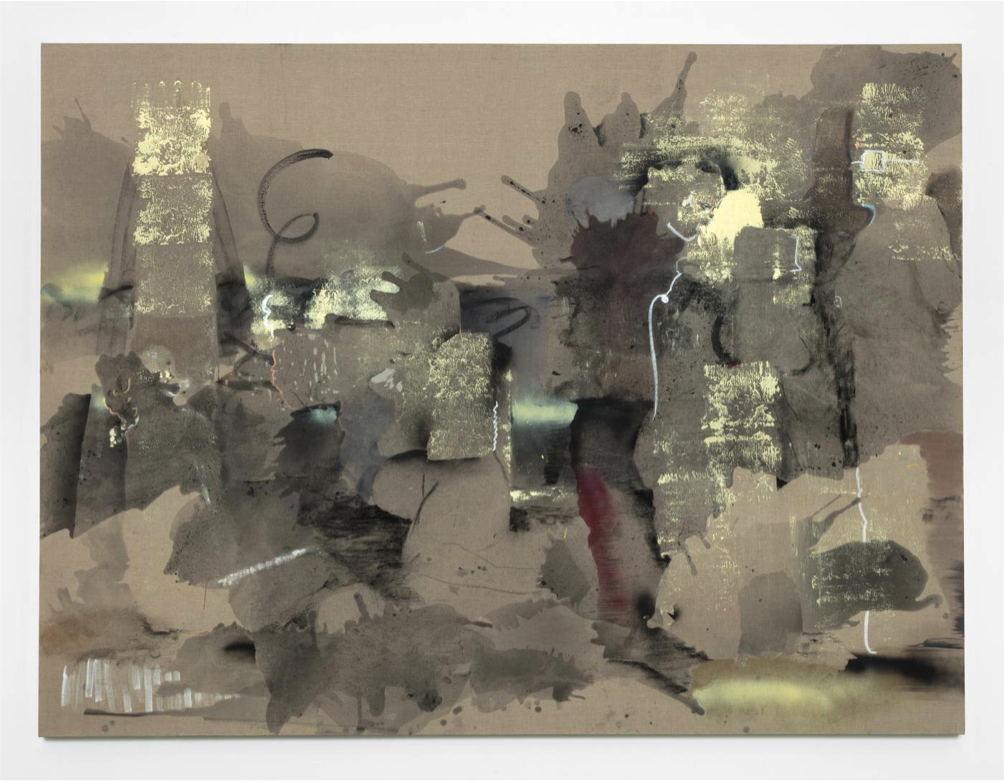
Annie Lapin, Stone Cabaret, 2016, oil stick, acrylic, charcoal and acrylic enamel spraypaint on linen
Starting this Friday, the LA-based artist Annie Lapin’s smudged, semi-abstract paintings are on show in How to Bury Your Stuff. Lapin’s energetic paintings are described as abstract imitations of realism, like loosely rendered collages of paint and akin to, in many ways, the Romantic landscape tradition.
Where: 44 – 46 Riding House Street, London W1W 7EX
When: 11 March – 8 April
Website: http://www.joshlilleygallery.com
Now on:
Gabriel Hartley: Light | Studio Leigh

detail from Gabriel Hartley’s Light, 2016
On Thursday the London-based artist Gabriel Hartley turns his hand to a new medium. Haled as an artist that redefined abstract expressionism, Hartley is now moving away from his history of painting and installation sculptures. In this solo show of his recent work Hartley uses glass to portray hazy, blurred environments with loose figures that take advantage of the differences in opacity and transparency – using light to create sense of depth from within the painting itself.
Where: 64 Garden Walk, London EC2A 3EQ
When: 10 March – 23 April
Website: http://studioleigh.com/
NEW YORK
Now on:
James Nares: Portraits | Paul Kasmin Gallery

Image Still: “Jahanara,” 2015. Video
British artist turned New Yorker, James Nares has been a regular to the scene since the late ’70s. In recent years, he’s been recognized mostly for elegantly expansive paintings centered around single brushstrokes made with what must be a gargantuan brush (or maybe a mop). Also a filmmaker, his latest show also involves slow-motion video, like his previous video titled Street, (scored by Sonic Youth frontman Thurston Moore), but now as a medium for portraits of friends and family captured in high-resolution detail. The results exist somewhere between still and moving pictures, where individual instances are able to be observed and analysed for stretched amount of time, adding nuances that would otherwise be ignored.
Where: 4293 Tenth Ave, New York 10001
When: 3 March – 23 April
Website: http://paulkasmingallery.com
Now on:
Karen Kilimnik | 303 Gallery
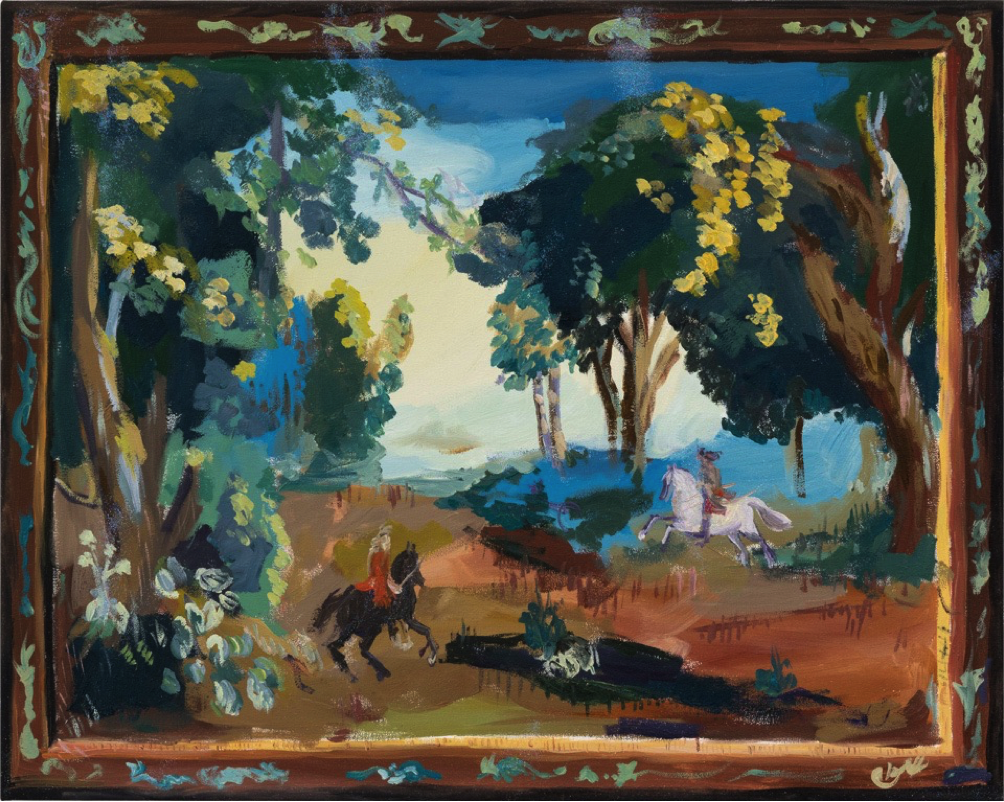
Karen Kilimnik, hunt for the dinner feast – in the forest with garlands and bow decor, water soluble oil on canvas, 2016
In new paintings and collages, Kilimnik creates richly enigmatic narratives, inscribing her images with references to histories of representation and myth. In her new paintings and a selection of new collages, Kilimnik mines the vernacular of tapestry reproductions of Baroque and Renaissance painting, with unexpectedly evocative notions introduced into art-historical scenarios simultaneously fantastical and plebeian. The use of tapestries as portals to enchanted worlds, rendered from classical landscapes, reveals the potential of reference that vibrates through Kilimnik’s work.
Where: 507 W 24th Street, New York, NY 10011
When: February 18 – March 26
Website: http://303gallery.com
Now on:
Crime Stories: Photography and Foul Play | Greene Naftali
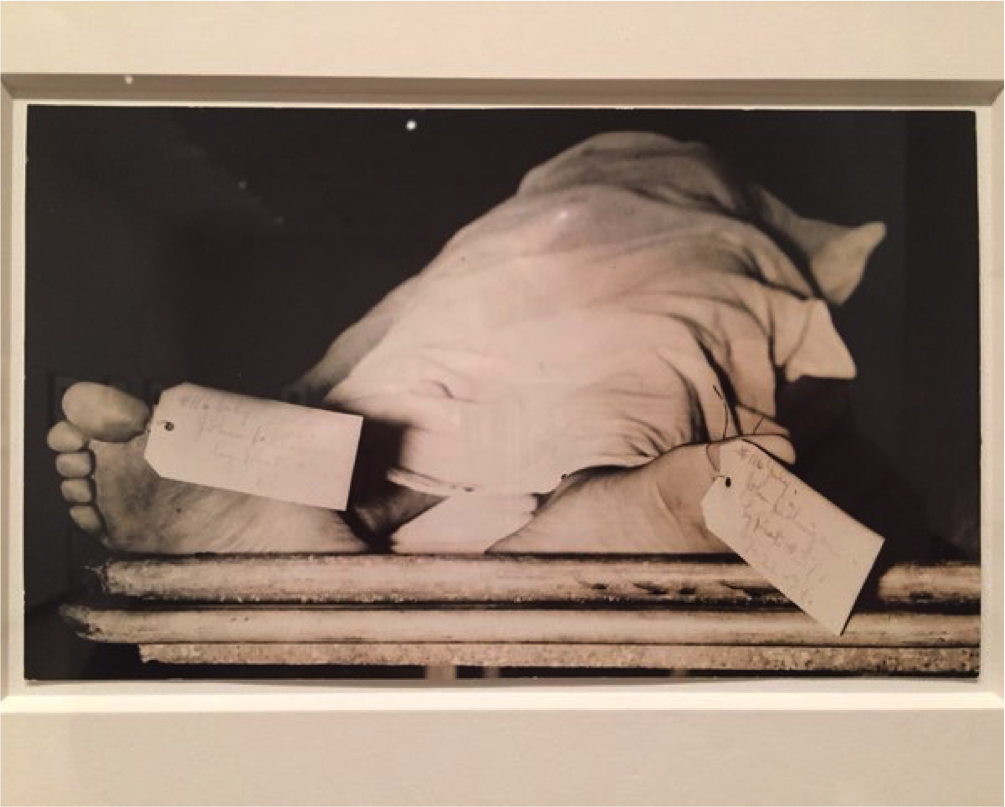
“John Dillinger, Chicago Morgue” 1934
The Metropolitan Museum of Art beginning Monday, explores intersections between photography and crime, from 19th-century “rogues’ galleries” to work by contemporary artists inspired the criminal underworld. Featuring around 70 works, ranging from the 1850s to the present, the camera’s role in police work is examined in the selection of mugshots, crime scene and forensic photos as well as news photographs related to criminal cases. Highlights include Alexander Gardner’s documentation of the events following Lincoln’s assassination as well as a study of John Dillinger’s feet in a Chicago morgue from 1934.
Where: 51000 Fifth Ave, New York 10028
When: 7 March – 31 July
Website: http://www.metmuseum.org
Now on:
Flatlands | Whitney Museum of American Art

Orion Martin, Bakers Steak, 2015. Oil on canvas
This exhibition brings together paintings by five artists—Nina Chanel Abney, Mathew Cerletty, Jamian Juliano-Villani, Caitlin Keogh, and Orion Martin. Highlighting an engagement with representation among some emerging artists, the works in this group conjure, like the illusionistic scenery flats used on stage and movie sets, a sense of space that is dimensionless and airless. Each of these artists fills their compositions with objects, environments and bodies that exaggerate and recontextualise, thus ‘real’ scenes become simplified and flattened. Imbued with references to the uncertainty of our sociopolitical moment as well as the seductive quality of consumerism, the paintings in Flatlands invite the viewer to reflect on the potential ambivalence of contemporary life.
Where: 99 Gansevoort St, New York 10014
When: 14 Jan – 17 Apr
Website: http://whitney.org
Now on:
Hiro | Pace/MacGill gallery
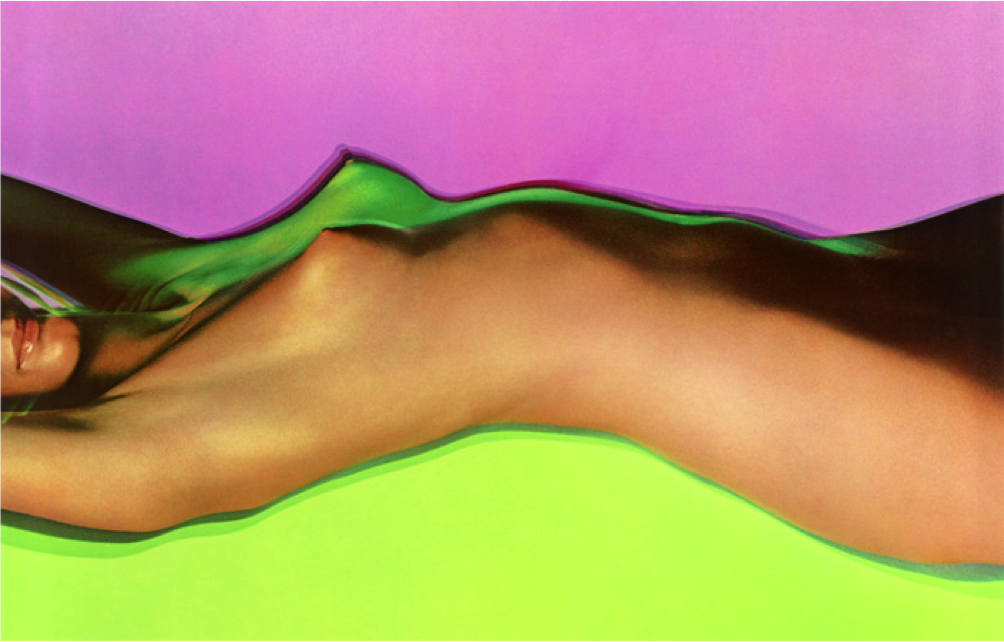
Hiro, Bodyscape New York, pigment print, 1976
Pace/MacGill is currently exhibiting a retrospective of works by the illustrious photographer Hiro, showcasing colour fashion images from the 60s and 70s alongside celebrity portraits and personal projects. Infused with an elegant sense of Surrealism, Hiro’s images embrace the use of bold colour, dynamic design, experimental lighting and unconventional compositional juxtapositions to transport viewers to illusory realms.
Where: 510 W 25th St, New York 10001
When: 25 February – 16 April
Website: http://www.pacemacgill.com